Amo questa scultura :
Studio questa scultura da più di 50 anni.
In questi 50 anni l’hanno vista, studiata, accarezzata Esperti, Storici dell’Arte, i più profondi conoscitori dell’arte di Pradier.
Tutti concordano : potrebbe essere di mano di Pradier.
L’idea originale è sicuramente di Pradier.
La data della sua creazione la scrive Pradier : è il 15 Luglio (o Agosto) del 1838.
Il titolo “La Naissance de l’Amour” l’ha dato Pradier.
E ad oggi questa scultura è l’unica versione in marmo di “La Naissance de l’Amour” che sia mai stata vista e studiata.
50 anni di studio e l’intervento di 16 Esperti hanno portato a questo risultato :
è ragionevole chiedersi se questo marmo possa essere di Pradier.
Arrivare ad un ragionevole dubbio è un buon risultato, un ottimo punto di arrivo. Più ancora è un ottimo punto di partenza.
Che questo marmo sia “DA” Pradier oggi è sicuro, ma se sia “DI” Pradier” è tutto da scoprire.
Tra il “DI” e il “DA” c’è un mare inesplorato da navigare. A fronte del mistero
Shakespeare ci apre orizzonti infiniti di speranza : “A mari inesplorati, spiagge insperate”.
Anche tu sei invitato a questa avventura.
Questa scultura di marmo bianco – cm 35 x 20 altezza 25cm e peso 12,9 kg -
è evidentemente ispirata al bronzo “La Naissance de l’Amour”
di Jean-Jacques “James” Pradier.
La Naissance de l’Amour.
L’invenzione di quest’opera è di
Jean Jacques ‘James’ Pradier (1790-1852)
ed ha una data precisa : il 15 Luglio 1838
Il 15 Luglio1838 infatti Pradier scrive una lettera a Juliette Drouet :
Juliette è un’attrice, oggi compagna di Victor Hugo. Ma quando aveva 19 anni Juliette è stata modella e amante di Pradier,
che l’ha ritratta (forse, ma forse no) in nudi molto sensuali :
I due hanno avuto una figlia, Claire :
… e anche adesso che Juliette è ufficialmente l’ufficiosa compagna di Hugo, peraltro sposato,
Pradier le racconta la sua giornata :
“Ho pensato anche a lui (Victor Hugo) perché soffrendo di una tremenda nevralgia
ho creato a letto una conchiglia aperta e dentro c’è Venere che ha appena fatto nascere l’Amore.
Appena (questa nuova scultura) sarà fusa voglio offrirgli la prima prova
e voglio farne fondere un piccolo bronzo e inviarlo al Duca d’Orleans
quando la principessa avrà partorito”.
L’invenzione (non la realizzazione) di questa scultura in marmo ha dunque
sia un autore sia una data certa : James Pradier e 15 Luglio 1838 a Parigi.
(Sulla “data certa” non siamo nemmeno tanto certi, ma sbagliamo di poco.
Mi scrive infatti Douglas Siler, che possiede la lettera originale :
“Helas, non : car la date de cette lettre n’est pas certaine. Louis Guimbaud la date du 15 juillet 1838 sur la base du cachet postal.
Mais ce cachet postal est incomplet et difficilement lisible. Ayant pu étudier ce cachet à la loupe après avoir acquis la lettre,
j’y lis hypothétiquement le 15 août 1838).
Per lo studio della mia scultura prezioso è stato il dialogo con Claude Lapaire
che proprio a quest’opera d’arte ha dedicato un intero saggio, dal titolo :
“Vénus dans la coquille, deux statuettes de James Pradier, sources et posteritè”,
in data 20/6/2009 e reperibile in Rete su “Forum Pradier”, creato e animato da Douglas Siler.
Claude Lapaire ha poi pubblicato il catalogo e fondamentale monografia :
“James Pradier (1790-1852). Et la sculpture francaise de la génération romantique”
5 Continents Editions, 2010
Su Claude Lapaire scrivo più a lungo con profonda riconoscenza nel primo commento alla fine di questo testo.
Altrettanto preziosa inoltre l’opera ancora in corso di pubblicazione “Correspondance” di Douglas Siler,
che ha avuto inoltre l’infinita gentilezza di leggere in bozze questo mio scritto.
Nel giro di poche ore Douglas Siler mi ha inviato una mail ricca di correzioni, suggerimenti e impeccabili informazioni.
Nel secondo ‘Commento’ alla fine di questo testo sintetizzo le preziose notizie
che Douglas Siler mi ha già regalato e aggiungerò le altre che ha promesso di inviarmi. Non lo ringrazierò mai abbastanza !
La mia domanda è :
questa versione in marmo de ”La Naissance de l’Amour”
potrebbe essere di mano di Jean-Jacques “James” Pradier ?
La prima ipotesi per una attribuzione è che chi ha scolpito in marmo
questa “Venere e Amore nella conchiglia” sia Jean-Jacques ‘James’ Pradier.
E’ lui che ha avuto l’idea, la cosiddetta ‘invenzione’
dell’opera che lui stesso ha battezzato “La Naissance de l’Amour”,
è lui che ha modellato la creta o la cera necessarie per la successiva fusione,
(Pradier modèle ses statuettes dans l’argile ou la cire),
è lui che ha rifinito le prime prove ottenute in bronzo.
Questa “ANaissance de l’Amour” però è realizzata
in un materiale diverso (marmo e non la cera o la creta e il successivo gesso,
usati per una fusione in bronzo),
è scolpita con una tecnica profondamente diversa (‘a levare’ anziché ‘a porre’),
è più grande del modello originale
e aggiunge importanti varianti, non presenti nell’opera originale.
Non si tratta quindi di una banale copia perché
chi fa una replica non modifica il modello originale.
E’ possibile, però non dimostrato, che Pradier possa aver realizzato
oltre che in bronzo anche in marmo la sua invenzione de “La Naissance de l’Amour”
e che quindi questa scultura in marmo sia opera di James Pradier.
La prima versione, quella di cui parla Pradier nella sua lettera del 15 Luglio (o Agosto) 1838,
era necessariamente un modello per la fusione in bronzo, visto che
sarebbe stato piuttosto problematico con “una tremenda nevralgia”
sbozzare a martellate o anche soltanto scalpellare un blocco di marmo stando a letto.
Però non si può escludere che, passata la nevralgia
e visto il successo della fusione in bronzo, Pradier abbia poi deciso
di realizzare la sua ‘invenzione’ anche in marmo.
Ci sono almeno 12 argomenti
a favore
dell’attribuzione di questo marmo
a James Pradier.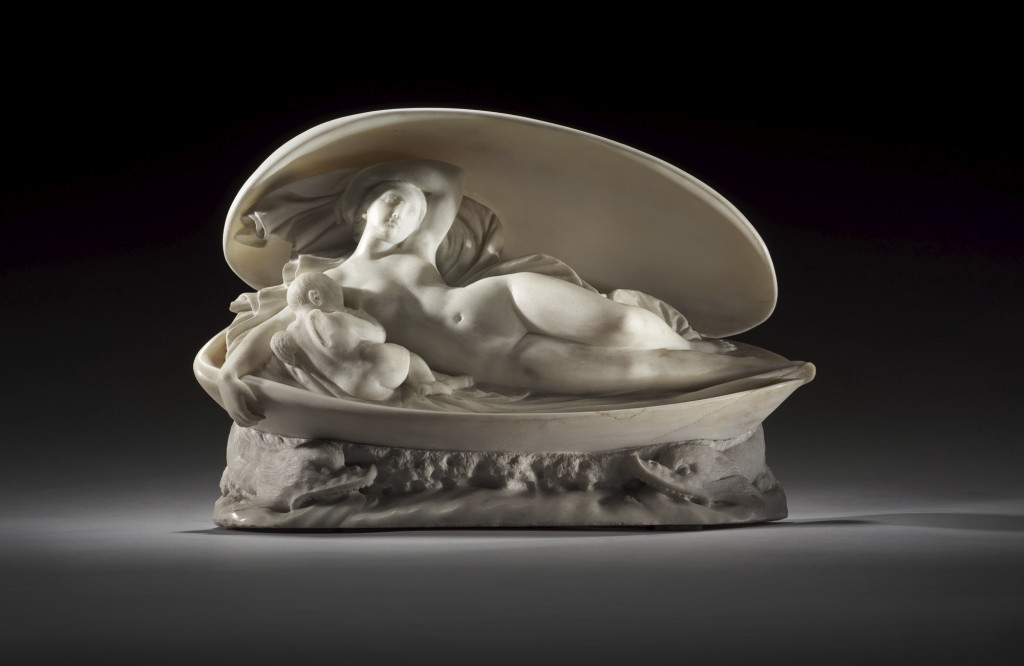
1
Pradier scolpisce il marmo.
Pradier è un grande scultore in marmo.
Sue opere sono regolarmente esposte, ammirate e favorevolmente recensite ai “Salon” al Louvre
e sono presenti in luoghi pubblici, Musei e collezioni private in Europa.
Pradier si dedica ad opere monumentali, ma anche ad opere di minori dimensioni,
quelle che Lapaire, Siler, de Caso e Garnier chiamano “statuettes”.
Le altre sculture in marmo di Pradier sono davvero molto simili a questa
e perciò sembra difficile escludere a priori che questo marmo sia di mano di Pradier.
2
Dal marmo al bronzo.
Di solito si replica in bronzo un’opera nata in marmo. Perché si fa ?
L’opera in marmo ha avuto successo, ma è un pezzo unico. L’artista vuole disporre
di più originali (multipli) e quindi, dopo il marmo, modella e poi fonde repliche in bronzo.
Per esempio (cfr Lapaire 2009) l’artista svizzero stabilitosi a Roma Heinrich Keller (1771-1832)
crea una “Venere nella conchiglia” in marmo, la firma e la data – H.KELLER F / ROMAE MDCCC).
Poi lui stesso ne fa sette repliche in marmo e due in alabastro.
Dopo di lui un tale Chiarelli ne fonde più di 13 ‘riduzioni’ in bronzo.
Quindi uno scultore, Keller, crea il marmo, poi ne fa lui 7 repliche in marmo e in alabastro.
Dopodiché, dai suoi marmi (“suoi”, non di altri) altri fanno poi molte repliche in bronzo.
3
Dal bronzo al marmo.
E’ frequente però anche il percorso contrario e cioè che da un originale in bronzo
l’artista decida poi di fare una replica in marmo, di maggiori dimensioni ed eventualmente con delle varianti.
Se questa “Naissance de l’Amour” fosse la replica autografa in marmo
di una sua ‘invenzione’ nata originariamente in bronzo,
non sarebbe certo per Pradier l’unica volta che ciò avviene.
Ed avviene per precise considerazioni sia operative che economiche.
Vedi “Statues de Chair” pagina 133, prima colonna, a proposito della scultura di Pradier “Odalisca”,
di cui esistono sia versioni bronzo sia una versione in marmo al Musèe de Lyon dal 1841.
“Difficile decidere in via definitiva sulla cronologia delle versioni in bronzo e di quella in marmo.
Non c’è nessun prova che l’opera in bronzo, di cui si conoscono versioni di almeno due diverse dimensioni,
sia come si è detto la versione ridotta del marmo esposto al Salon del 1841.
Secondo la convinzione di molti critici che la recensirono in quella occasione (tra questi Théophile Gautier)
questa sarebbe la prova di una pratica di Pradier, confermata dalla giurisprudenza dell’epoca,
per cui in alcune occasioni Pradier avrebbe ‘sperimentato’ in qualche modo un soggetto (una sua ‘invenzione)
nel piccolo formato della ‘statuetta’ per vedere se aveva successo
prima di investire nei costi di una realizzazione in marmo e affrontare, per così dire, i rischi del Salon”.
E ancora alla stessa pagina 133 alla nota 11 : “ In vita lo scultore Pradier aveva ceduto a diversi editori
il diritto di riproduzione di sue opere. La maggior parte di queste erano nate nelle dimensioni di semplici statutette,
ed era soltanto dopo averle messe in commercio come moulages, che lui (Pradier)
decideva di riprodurre in grande quelle che avevano ottenuto più successo”.
Ancora più oltre, Guillaume Garnier in “Statues de Chair” pagina 246, terza colonna :
“In alcuni casi la ‘statuetta’ in bronzo o in gesso ha preceduto l’opera di grande formato in marmo”:
In sintesi questi testi confermano che poteva succedere, e succedeva,
che Pradier creasse in piccole dimensioni e fondesse in bronzo e mettesse in commercio
delle piccole sculture di sua “invenzione”e decidesse poi di realizzare la stessa invenzione in marmo
se i bronzi avevano avuto successo. Marketing research ante litteram.
Perciò questo marmo potrebbe essere una scultura di mano di Pradier stesso,
replica in marmo della sua invenzione de “La Naissance de l’Amour”
visto l’immediato successo (§ 10 più oltre) che l’opera in bronzo aveva raccolto.
4
Marmo e bronzo : due arti diverse.
La tecnica dello scolpire in marmo, “per forza di levare” è profondamente diversa,
sia fisicamente sia concettualmente, dalla tecnica del modellare in bronzo, “per via di porre”,
creando prima un modello in creta o cera destinato poi alla fusione
e rifinendo poi ed eventualmente patinando il bronzo.
Le differenze tra questa versione in marmo de “La Naissance de l’Amour”
rispetto alle versioni in bronzo possono essere giustificate dai diversi risultati
che uno stesso artista ottiene quando crea con il marmo, quindi ‘a levare’
rispetto a quando crea il modello per una fusione in bronzo, quindi per via di porre’.
E’ vero : ci sono minime differenze tra le versioni in bronzo e la versione in marmo
de “La Naissance de l’Amour”, ma queste differenze sono ampiamente spiegabili
con le due diverse tecniche di creazione : sono diversi i due momenti della lavorazione;
diversi i luoghi dove lavorare (un marmo richiede di lavorare in un ampio studio,
la cera volendo si può anche modellare, come scrive Pradier, stando a letto
o comunque in una camera di casa);
diversi i tempi per la realizzazione (minuti, forse ore per un modello in cera;
ore e forse giorni per un marmo);
diversa infine la possibilità che in un marmo intervengano assistenti o allievi
per una prima sbozzatura del masso, mentre ciò non avviene
modellando la cera o la creta per un bronzo.
C’è un’ulteriore considerazione da approfondire sulla differenza dell’esecuzione
di una stessa idea – nata per esempio da un rapido schizzo o da un accurato disegno dell’artista -
in marmo oppure in bronzo.
C’è una profonda differenza sia in fase di realizzazione, sia come prezzo di vendita.
Per chi la acquista una scultura in marmo è inevitabilmente più costosa di una scultura in bronzo,
di cui già esistono o potranno in futuro esistere repliche (multipli)
che quindi diminuiscono l’unicità e la rarità dell’opera.
Questo maggior costo riduce il numero dei potenziali acquirenti
a pochi mecenati e allo Stato o alle Commissioni Pubbliche.
Per l’artista la scultura monumentale in marmo comporta alti costi di realizzazione
e minori opportunità di vendita.
Invece la sculture di piccole dimensioni – le ‘statuettes’ – costano all’artista molto meno
e sono accessibili ad un più ampio mercato. Marketing strategy ante-litteram.
Le statuettes di Pradier sono infatti subito apprezzatissime
sia nelle gallerie dei privati collezionisti d’arte per l’inventiva seducente e maliziosa,
sia nei boudoir e nei pied-à-terre di galanti intenditori
per gli eleganti e raffinati echi erotici
(Guillaume Garnier in “Statues de Chair” pagina 246, prima colonna).
5
Marmo e bronzo : due sculture simili.
Ci sono però somiglianze molto più evidenti che non le differenze
tra questa scultura in marmo, le versioni in bronzo dello stesso soggetto
e anche con altre sculture in marmo di James Pradier :
i piedi,
il tessuto che si infila tra le dita del piede destro di Venere ….
particolari anatomici caratteristici
(i motivi-sigla o ‘cifre’ di Giovanni Morelli) e ricorrenti nell’arte di James Pradier.
Questi punti di innegabile contatto portano
se non a confermare quantomeno a non escludere un’unica paternità
sia per le ‘statuettes’ in bronzo che per questo marmo : la mano di James Pradier.
6
In marmo i delfini, in bronzo no.
La presenza dei due delfini in questa “La Naissance de l’Amour” in marmo,
delfini che mancano invece in tutte le versioni in bronzo,
ma sono presenti nella verticale “Venere nella conchiglia” sempre di Pradier, circa 1840
merita attenzione.
E’ raro che chi replica l’opera famosa di un altro artista si azzardi
a modificare l’opera che sta copiando ed inserisca nella sua copia elementi
che non sono presenti nell’originale che sta copiando.
Nell’originale di bronzo de “La Naissance de l’Amour” i due delfini non ci sono,
in questo marmo de “La Naissance de l’Amour” i due delfini ci sono :
perché un ‘replicante’ dovrebbe aggiungere un brano così vistoso
se il suo obiettivo è la fedele riproduzione di un modello originale e già famoso ?
Chi fa una copia sa che il destinatario (committente o potenziale acquirente)
della sua replica vuole proprio una fedele riproduzione e non una variazione sul tema.
La presenza dei due delfini in questa scultura in marmo -
delfini che mancano invece in tutte le versioni in bronzo de “La Naissance de l’Amour” –
fa pensare
più all’opera di un artista che crea che non all’opera di chi replica un’opera famosa.
Sembra quindi più logico pensare che James Pradier –
visto il successo delle sue due prime fusioni in bronzo -
abbia deciso di realizzare anche una nuova versione in marmo.
Passando a un materiale così diverso (dalla calda malleabilità di cera o creta
alla fredda e ostile durezza del blocco di marmo) e ad una tecnica di scultura profondamente diversa
Pradier ha poi deciso di modificare le dimensione del bozzetto originario,
per scolpire un marmo più maestoso e più imponente
che non i due primi bronzetti, cha Lapaire chiama “statuettes”.
E soprattutto è possibile che Pradier abbia deciso di aggiungere alcune varianti –
il mare tempestoso e i due mostruosi delfini – proprio per sottolineare
la paternità e l’originalità di questa sua ‘variazione sul tema’.
E’ perciò inevitabile quantomeno chiedersi : potrebbe essere James Pradier
lo scultore che ha modellato in marmo questa versione, più grande e con varianti,
della sua originale “Naissance de l’Amour” in bronzo ?
7
Vietato riprodurmi in marmo.
Pradier ha sempre dato precise istruzioni e limitazioni sulla possibilità di fare repliche delle sue opere :
(cfr Lapaire ) “… Pour la Venus à la coquille Salvatore Marchi … avait le droit de reproduction en bronze seulement”.
Altrove Pradier precisa : “A vendre le droit de reproduction en bronze seulement”,
o anche “le droit de reproduction en plātre”.
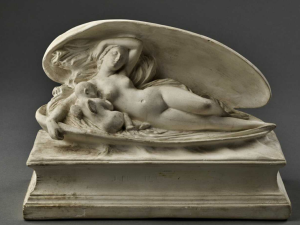
Stranamente la mano destra di Afrodite del calco in gesso di Ginevra qui sopra
è molto più simile alla mano del mio marmo (nota la diversa inclinazione inclinazione del pollice !)
che non alla mano del bronzo.
Eppure il gesso dovrebbe essere una copia fedele di un modello originale :
si potrebbe pensare allora che il gesso di Ginevra
sia una copia del marmo e non del bronzo de “La Naissance de l’Amour” ?
Però mai Pradier consente il diritto di riproduzione in marmo,
sia perché probabilmente non era pensabile che accadesse,
sia perché non intendeva affidare ad altri la riproduzione in marmo di una sua creazione.
Visto che altri potevano riprodurre solamente in bronzo “La Naissance de l’Amour”,
allora potrebbe essere J-J. Pradier, e non altri, lo scultore che ha modellato in marmo
questa versione, più grande e con varianti, della sua originale “Naissance de l’Amour” in bronzo.
8
Nei testi solo un marmo. Mai visto però.
In più, sempre Lapaire scrive : “La Naissance de l’Amour” est restée pratiquement sans postérité
bien qu’elle ait eté largement diffusée par l’edition.
Les sculpteurs semblent ne pas l’avoir copiée.”
Da un lato sembrerebbe che, tranne la scultura qui oggetto di studio,
non sia nota nessun’altra versione in marmo de “La Naissance de l’Amour”.
D’altro lato il 2 Dicembre 2019 mi scrive Douglas Siler :
“Jacques de Caso l’a également étudiée, brièvement,
dans le catalogue de l’exposition Statues de chair (Genève et Paris, 1985-1986) :
Là, dans une note (Nota 1 pagina 280) sur les différentes versions connues de l’oeuvre, il mentionne
qu’il « s’en trouvrerait une, agrandie, en marbre, dans une collection anglaise ».
Se, come scrive Lapaire, “nessuno l’ha mai copiata” in marmo
oppure se, come scrive de Caso, forse una replica in marmo si troverebbe in una collezione privata nel Regno Unito,
perché escludere a-priori che la mia scultura sia di mano di Pradier ?
9
Nelle Aste mai visto in marmo.
Il Forum Pradier (www.jamespradier.com) registra sotto “Ventes” le opere di Pradier
apparse in Asta nel mondo negli anni tra 2003 e 2017 ed anche alcune altre proposte fuori Asta.
Su centinaia di lotti proposti, a volte aggiudicati e a volte no
e più volte ripresentati anche a distanza di pochi mesi,
non ce n’è uno solo che rappresenti “La Naissance de l’Amour” in marmo.
Ci sono state 6 versioni in bronzo, negli anni 2008-9-14-15 e 16;
una versione in gesso dipinto nel 2011; una in bisquit nel 2010 e persino una in avorio nel 2016.
Però mai una versione de “La Naissance de l’Amour” in marmo !
Forse questo dato di fatto significa qualcosa :
innanzitutto conferma quanto scrive qui sopra Claude Lapaire
che “La Naissance de l’Amour” nessuno l’ha mai copiata in marmo.
Inoltre il fatto che questa versione in marmo sembri essere ad oggi
un ‘unicum’ nella pur vasta letteratura su Pradier potrebbe rafforzare la tesi
che questa scultura possa essere non soltanto DA Pradier, ma anche DI Pradier.
10
Successo immediato.
La “Naissance de l’Amour” è subito talmente amata e famosa
che appare già – due anni appena dopo la sua ‘invenzione’ –
in un volume del 1840 ‘Les Français peints par eux-même’,
come presente e protagonista nella WunderKammer di una ipotetica “Chanoinesse” :
L’immagine, anche se speculare, come sempre succede nella grafica,
è indiscutibile e la scultura di Pradier qui evocata e rappresentata così bianca e abbagliante
potrebbe benissimo essere un marmo e non un bronzo.
Peralto, mi indica Siler, non soltanto l’Afrodite nella conchiglia è indiscutibilmente opera di Pradier,
e rappresentata così bianca e abbagliante potrebbe benissimo essere un marmo e non un bronzo.
ma è di Pradier anche l’altra scultura presente nell’illustrazione al centro :
“Juste. A noter que la statuette debout est La femme se lavant les cheveux de Pradier, qui date de 1840 – cat. Lapaire, n° 146.)”
Siamo sempre nel 1840. Gustave Flaubert deve ‘arredare’ l’appartamento di un suo giovane protagonista
che, innamorato perso della moglie di un mercante di opere d’arte, dilapida i soldi che non ha in dipinti e sculture.
Ed ecco nell’appartamento che il giovane divide con un amico povero come lui :
“ … una veduta di Venezia, una di Napoli, una di Costantinopoli …
e sulla mensola del caminetto un gruppo di Pradier”.
(Gustave Flaubert “L’éducation sentimentale”. Première partie. Chapitre V)
“Un groupe de Pradier sur la cheminèe” non può certo essere una scultura monumentale :
molto più probabile che sia una delle sue ‘statuettes”, da subito così famose.
E siccome i giovani in quella stanza poco prima hanno parlato proprio di “tante Veneri”,
perché non pensare che la scultura di Pradier sul caminetto
sia forse – e sottolineo forse – il marmo de “La Naissance de l’Amour” ?
11
Provenienza prestigiosa.
La provenienza di questa scultura di marmo è di grande prestigio.
E’ stata acquistata negli anni ’70 presso la Villa Crivelli :
proprio nel momento in cui venivano dispersi dall’ultimo erede della famiglia Crivelli
i dipinti e le sculture antiche di una collezione famosa e apprezzata da illustri visitatori :
da Carlo Goldoni ad Antonio Canova e Giuseppe Bossi, Stendhal e Alessandro Manzoni.
provenienza : “ Villa Crivelli ad Arese”. probabilmente questa villa è :
Villa Arconati detta “Il Castellazzo” a Castellazzo di Bollate (Milano)
https://it.wikipedia.org/wiki/Villa_Arconati
abitata da Vitaliano Crivelli (1806-1873) collezionista di arte neo-classica
e infine ceduta da Vitaliano Crivelli, IX marchese di Agliate, negli anni ’70 del secolo scorso.
12
Il collezionista ricco compera originali.
La presenza di una copia in una collezione famosa non ha molto senso.
Perché mai Vitaliano Crivelli, collezionista molto ricco, colto e ben consigliato,
avrebbe dovuto acquistare per la sua famosa collezione
la replica di una famosa scultura, però diversa dall’originale
perché realizzata in un diverso materiale (marmo anziché bronzo),
di diverse dimensioni (molto più grande)
e con delle varianti iconografiche (i delfini) non presenti nell’originale,
quando avrebbe potuto tranquillamente acquistare un originale ?
Sembrerebbe più logico ipotizzare che il famoso e colto collezionista
si sia procurato per la propria collezione un originale,
di mano dell’artista creatore dell’invenzione della “Naissance de l’Amour”
anziché una copia di ignoto scultore. Potrebbe aver cercato e ottenuto
l’unico originale esistente di un’opera già molto famosa in Europa,
opera era però reperibile soltanto in bronzo, però mai in marmo.
Per un raffinato collezionista senza problemi economici,
la rarità e unicità di un’opera
sono un obiettivo che giustifica qualsiasi spesa.
C’è però anche un autorevole parere contrario all’attribuire
a James Pradier la realizzazione di questa scultura in marmo.
Un lungo dialogo via mail con il Professor Claude Lapaire
e il suo esame di molte fotografie di questo marmo, però mai del marmo originale
e quindi mai con la possibilità di vederlo dal vero, toccarlo, accarezzarlo e studiarlo a fondo,
portano Claude Lapaire a scrivermi:
Cher Monsieur,
vos nouvelles photos me permettent de mieux comprendre votre marbre …
Pradier a fait faire par ses praticiens un très petit nombre de réductions en marbre
de ses grandes statues. …
Du vivant de l’artiste, ou plus tard, avec l’accord de ses héritiers,
aucune autre statuette de Pradier n’a été reproduite en marbre…..
votre Naissance de Vénus me paraît une réplique légèrement agrandie
et soigneusement exécutée de l’original de Pradier,
intelligemment modifiée par l’adjonction des deux dauphins.
Je ne suis pas à même de dire quand et où ce marbre a été taillé,
mais certainement pas par Pradier ou ses collaborateurs.
Claude Lapaire
Claude Lapaire mi scrive queste righe il 5 Dicembre 2019.
Forse oggi qualcuno dei 12 argomenti che ho proposto qui sopra per sostenere la possibilità
(non la “certezza” : la possibilità !) che questa scultura di marmo sia opera della mano DI Pradier
potrà convincere Claude Lapaire e Douglas Siler e Jacques de Caso e qualche appassionato Lettore del Forum Pradier.
Forse le mie 12 argomentazioni potranno non dico persuadere, ma almeno far nascere il dubbio
che questa versione in marmo de “La Naissance de l’Amour” -
l’unica ad oggi nota e documentata con fotografie, confronti puntali con le versioni in bronzo
e con altre opere di Pradier, con provenienza e storia del suo percorso collezionistico –
possa essere (non ”sia” : possa essere) non soltanto DA Pradier, ma DI Pradier.
O forse no.
Ma comunque è stato bello studiare questa scultura, è stato interessante ed istruttivo frequentare il Forum Pradier,
è stato emozionante scoprire la gentilezza e la disponibilità di grandi esperti come Claude Lapaire e Douglas Siler,
persone di una umanità ed eleganza culturale oggi rarissime.
E sarà sicuramente emozionante leggere le opinioni di tutti coloro che come me amano James Pradier
e la sua ‘invenzione’ de “La Naissance de l’Amour”
Il dialogo con il Professor Lapaire è ancora in corso e attendo da lui i motivi che lo hanno portato alla sua decisione :
quali sono i particolari, i dettagli significativi che lo inducono ad escludere la mano di James Pradier e del suo atelier da questo marmo.
Douglas Siler mi dice che dalle foto è impossibile sia confermare sia escludere l’attribuzione dell’opera a James Pradier.
Certo, l’ideale sarebbe portare il marmo a Ginevra oppure ospitare Claude Lapaire e Douglas Siler a Venezia : chissà che non possa succedere.
Fino a quel momento però l’attribuzione de “La Naissance de l’Amour” in marmo a James Pradier
rimane una delle ipotesi di ricerca possibili, forse la più probabile, ma si deve anche estendere
la ricerca ad altri nomi, ad altre date e a diverse località, rispetto a Parigi.
Se questa versione in marmo de “La Naissance de l’Amour”
non è DI Pradier,
oggi non c’è ormai più dubbio che sia DA Pradier.
Non sempre è stato così : per anni molti l’hanno vista e studiata senza scoprire
che ha una sua fonte iconografica indiscutibile ed anche una data certa per l’invenzione
(la lettera di James Pradier del 15 Luglio 1838).
In questo nuovo filone di ricerca allora il problema diventa :
se questa scultura di marmo non è DI Pradier,
CHI l’ha scolpita ?
e DOVE ? e QUANDO ?
e PERCHE’ copiare una scultura famosa, però modificandola ?
Per rispondere a queste nuove domande bisogna individuare uno scultore
che non sia un banale ‘replicante’.
Questo scultore da individuare è sicuramente un artista dotato di grande talento
e raffinata manualità. Non può essere un allievo di Accademia, non può essere
un ‘copista’ che lavora su ordinazione.
Chi ha scolpito questo marmo deve essere un autore originale, che può anche decidere
di ispirarsi ad un’opera altrui, ma è abbastanza coraggioso da azzardarsi a modificare
un modello già famoso, opera di un artista molto noto e apprezzato.
Per esempio, in questo marmo è ancora più sottolineato che non nei bronzi
il contrasto tra fronte e retro :
la visione frontale di una finitezza abbagliante,
di contro la visione posteriore volutamente lasciata ed esibita a non-finito
con evidenti tracce dei colpi di scalpello.
Ma c’è di più : nel marmo è evidente l’espressione originale di un forte contrasto
tra bellezza vs mostruosità, tra Umanità contro Natura :
Umanità, affascinante nel nudo femminile
e teneramente affettuosa nel gesto del piccolo Amore
opposta a
una Natura minacciosa (le onde tempestose) e abitata da mostri marini
(i delfini francamente molto più brutti e inverosimili
degli eleganti e simpatici animali che dovrebbero rappresentare).
Questo marmo quindi non è una replica, ma è l’invenzione originale,
di un artista per ora non individuato, che può essere uno scultore
che crea con il marmo tra il 1838, data post quem,
perché dettata dalla lettera di Pradier stesso,
e il 1873, data ante quem sia perché il 1873 è l’anno in cui muore Vitaliano Crivelli,
che quindi termina l’acquisizione di opere d’arte per la sua collezione.
La seconda metà del secolo 19° è inoltre una datazione confermata
da diversi studiosi, che pure mai hanno fatto riferimento a Pradier.
Prima di individuare il bronzo del 1838 de “La Naissance de l’Amour” di Pradier,
per anni ho mostrato la mia scultura e inviato fotografie
a vari studiosi ed esperti di scultura dell’800.
Vincenzo Vicario, Anthony Ratcliffe del Victoria & Albert Museum,
Carlo Ludovico Ragghianti, Raffaele Monti, Eugenio Riccomini :
tutti, sempre gentilissimi e disponibili, mi hanno proposto la loro interpretazione di questo marmo.
Per tutti la datazione era seconda metà del 19° secolo,
anche se di volta in volta variava l’attribuzione ad un artista.
Chi sia questo per ora non identificato scultore, la cui opera è realizzata
prima del 1873, è domanda per ora, ma non per sempre, senza risposta.
Ipotesi di lavoro
per un’attribuzione alternativa a James Pradier :
1
E’ un giovane dotato scultore francese
che forse partecipa per il ‘Prix de Rome’ alle candidature per il soggiorno a Villa Medici.
Questo scultore potrebbe aver deciso di replicare un’opera già famosa in Francia,
perché vuole mostrarsi dotato non solo di straordinaria abilità tecnica nella lavorazione del marmo,
ma anche capace di creatività, apportando all’opera da tutti conosciuta
notevoli personali innovazioni.
Artisti da studiare sono sicuramente gli oltre 20 allievi conosciuti di Pradier.
Tra questi :
Eugène-Louis Lequesne (1815-1887) nello studio di Pradier dal 1841
Eugène Guillaume (1822-19095) con Pradier dall’Aprile 1841
Célestin-Anatole Calmels (1822-1906)
Eugène Gonon (1814-1891) autore del saggio manoscritto “L’arte di fondere il bronzo a cera persa” (1876),
realizzatore di fusioni a cera persa per Pradier e scultore egli stesso.
Aubin (1822-1895) a cui nel 1841 Pradier commissiona un abbozzo in marmo
della “Venere e Amore” oggi all’Hermitage :
è forse Aubin Antoine Durenne ? fonditore e anche scultore ?
Nicolas-Victor Vilain (1818-1893) autore di un sensibile ritratto di Claire,
figlia di Pradier e di Juliette Drouet
2
E’ un giovane scultore tedesco
In quegli anni si conosce in Germania la “Naissance de l’Amour” di Pradier. L’opera è già così famosa ed amata che la Regia Manifattura di Porcellane di Berlino (Königliche Porzellan-Manufaktur Berlin) decide di produrne riproduzioni in porcellana dipinta e con un marchio documentato negli anni tra il 1837-1844.
Uno scultore tedesco per ora non individuato,
sia che abbia visto gli originali in bronzo di Pradier o incisioni che li riproducono,
sia che abbia soltanto visto le porcellane KPM che li rendono popolari,
travisandone però lo spirito (Venere con cipria e rossetto !)
decide invece di dare una propria interpretazione di quell’opera,
scolpendo un marmo, di diverse dimensioni e con proprie personali aggiunte.
3
E’ uno scultore italiano, operante forse a Roma.
Tra il Settembre del 1841 e il Marzo del 1842, quindi alcuni anni dopo la creazione
de “La Naissance de l’Amour”, Pradier soggiorna a lungo a Roma
insieme ad alcuni giovani allievi, Guillaume e Lequesne.
A Roma Pradier lavora in un suo atelier, ha importanti commissioni e (scrive Lapaire)
“ha contatti con i cavatori di marmo di Carrara”.
Se ha contatti con i cavatori di marmo, è probabile che abbia anche scolpito in marmo.
In questi mesi Pradier ha sicuramente contatti anche con l’ambiente artistico italiano,
quindi anche con altri scultori attivi in quel periodo a Roma.
Non si può nemmeno escludere che Pradier abbia con sé, o trovi a Roma,
qualche replica dei suoi bronzi originali della Venere nella conchiglia.
Qualche artista italiano potrebbe allora decidere di replicare in marmo, con proprie varianti,
l’opera di Pradier. Questo scultore italiano potrebbe essere :
3.1 Gaetano Rossi (1829 -….)
Un bronzetto (circa cm 15 x 12 contro i cm 35 x 25 del marmo), visto negli anni ’70
da un antiquario a Roma, in via dei Coronari e purtroppo non fotografato,
replicava perfettamente forse il bronzo di Pradier o forse proprio questo marmo.
Il bronzetto era siglato sul retro “G. de Rossi a Roma” e quindi
se l’autore del bronzetto fosse Gaetano Rossi, che si firma “G. de Rossi a Roma”,
allora egli stesso potrebbe essere l’autore di questo marmo.
Sono documentati marmi di Gaetano Rossi molti simili a questo.
Proprio il nome di Gaetano Rossi suggeriva Vincenzo Vicario,
autore della monumentale opera in 2 volumi
“Gli scultori italiani dal Neo-classicismo al Liberty”,
scrivendomi il 19 Maggio 1994:
“… la Sua “Venere appartiene alla seconda metà dell’Ottocento,
peraltro io direi all’inizio di tale periodo e cioè circa al primo decennio dal 1850.
Io penso che la Sua scultura possa essere attribuita al napoletano Gaetano Rossi …
egli fu ritrattista, ma soprattutto esecutore di sculture di genere, quali …”Venere” …
si dedicò prevalentemente ad eseguire copie delle antiche statue …”
Eugenio Riccomini che mi scrive nel 1991 :
“ .. la Sua delicata statua mi pare che abbia poco a che fare con Giacomo Rossi bolognese
che studiai a suo tempo e che era più ardimentoso e focoso.
Tra l’altro mi sembra che la Sua opera sia di data più tarda, già Ottocento avanzato.”
Stranamente tutti gli esperti italiani ed inglesi consultati
prima che io scoprissi il bronzo di Pradier non avevano però individuato
ne “La Naissance de l’Amour” creata nel 1838 da James Pradier,
l’invenzione originale di questa immagine
a cui il marmo inevitabilmente si ispira pur procedendo poi a notevoli varianti.
In questo ‘giallo’ la ricerca del responsabile del ‘corpo del reato’ propone però oggi
un nuovo sospettato : Carlo Finelli (1785-1853) scultore in Roma.
3.2
Carlo Finelli (1785-1853)
“ … Il padre, discendente da una famiglia di scultori, lo avvia all’arte fin da piccolo. …
Tra il 1814 e il 1815, Carlo Finelli comincia a scolpire una serie di opere di soggetto mitologico,
tra cui Venere nascente da una conchiglia
e Psiche e le Ore danzanti, ispirata a tre Grazie di Canova…
Ancora, in questi anni Finelli si trovò alle prese con numerose opere commissionategli
da importanti personaggi, soprattutto inglesi e russi….
Del periodo 1825-1830 sono le opere Venere che raccoglie le vesti, Amore con farfalla
e Pastorella con i fiori, eseguite per il duca del Devonshire…
Morì nel suo studio di Roma nel 1853. “
Queste date, le notizie biografiche e le pochissime sue opere ad oggi reperite, suggeriscono
di dedicare una più approfondita indagine anche a Carlo Finelli, di cui già Lapaire
pubblica una “Venere nella conchiglia” assai vicina al marmo su cui stiamo indagando.
Sintesi dei pareri raccolti negli anni che precedono l’individuazione del bronzo originale di Pradier.
I pareri scritti sono disponibili in originale :
1
Anthony Radcliff (Victoria & Albert Museum)
da fotografie comunicazione verbale 17.2.1984 –
“Molto probabilmente Milano, 1850 non oltre 1870,
scuola o cerchia di Raffaele Monti (1818-1881)
2
Carlo Ludovico Ragghianti
da fotografie, comunicazione verbale di Raffaele Monti
che ha studiato la scultura a Milano e concorda con il parere di Ragghianti :
“Iconografia neo-classica, fine ‘700. Il pezzo può essere accademico o anche del primo Novecento”.
3
Eugenio Riccomini,
da fotografie – comunicazione autografa 1991.
“ .. la Sua delicata statua mi pare che abbia poco a che fare con Giacomo Rossi bolognese
che studiai a suo tempo e che era più ardimentoso e focoso.
Tra l’altro mi sembra che la Sua opera sia di data più tarda, già Ottocento avanzato.”
4
Vincenzo Vicario
autore de “Gli scultori italiani dal Neo-classico al Liberty”,
da fotografie – comunicazione autografa 19 maggio 1994 –
“ .. essa appartiene alla seconda metà dell’Ottocento, peraltro io direi
all’inizio di tale periodo e cioè circa al primo decennio dal 1850.”
*
Bronzetto a Roma :
negli anni ’70 un antiquario in Via de’ Coronari a Roma propone una perfetta replica
di questo marmo, però in bronzo e più piccolo (circa cm 15 x 12 contro i 35 x 25 del marmo),
siglata “G. De Rossi a Roma” sul retro della conchiglia.
Purtroppo non fotografata e mai più ritrovata.
**
Porcellana KPM Berlino 1837-1844
la porcellana dipinta è prodotta dalla KPM Regia Manifattura di Porcellane di Berlino
Königliche Porzellan-Manufaktur Berlin
KPM ha usato questo marchio con scettro e aquila nel periodo : 1837-1844. O forse 1849-1870.
La porcellana, non fosse altro per come è dipinta,
sembra riprodurre ed evocare una scultura in marmo e non una scultura in bronzo :
In sintesi : se la porcellana KPM di Berlino riproduce il bronzo,
si sa che il bronzo è del 1838 e degli anni seguenti;
ma se la porcellana riproduce non il bronzo, ma il marmo ad oggi a tutti ignoto,
allora il marmo perché un artigiano ceramista tedesco potesse conoscerlo e modellarlo
deve essere anteriore al 1844 o comunque scolpito nel periodo 1837-1844.
Agenda :
Altre ricerche bisogna approfondire sui collaboratori a cui Pradier affidava
la riproduzione delle sue opere. Sono titolari di laboratori di fusione, tra cui :
Salvatore Marchi, Hèbert frères, Bonnet, Honorè e poi Eugène Gonon e altri.
Bisogna cercare anche se esiste una catalogo della collezione d’arte di Villa Arconati
e un catalogo della dispersione all’asta della collezione negli anni ’60-70 del secolo scorso.
La ricerca su questa scultura in marmo è attualmente in corso sia in Svizzera (C.L.),
sia in Belgio (D.S.), sia in Italia. E’ quindi opportuno per il momento
rimandare ogni decisione su attribuzione e datazione della scultura.
(continua)
Il testo che segue ha rilevanza solo personale, ma nulla aggiunge
alla ricerca se “La Naissance de l’Amour” in marmo oggetto di questo studio
sia di mano di Pradier e, se non lo è, di chi potrebbe essere.
Franco Bellino
Venezia 9 novembre 2019 – 9 settembre 2021
Ecco degli appunti scritti tanti anni fa : sono righe di nessun valore scientifico,
ma che giustificano la dichiarazione d’amore per questa scultura con cui ho aperto questo scritto.
Scopro la scultura in via san Vitale a Bologna … entro in galleria :
la studio, la guardo a lungo, la accarezzo : sono già innamorato.
Mi colpisce il contrasto tra la levigatezza sensuale del corpo di Afrodite
e di contro la brutale rozzezza del retro della conchiglia :
è un voluto non-finito che parla della decisione di un artista
che gioca e sapientemente orchestra brutali contrasti :
fronte contro retro
sul fronte la levigatezza sensuale del viso e del corpo di Afrodite
sul retro : la brutale rozzezza del retro della conchiglia, appena sbozzato
e deliberatamente/provocatoriamente proposto come non-finito.
alto contro basso
in alto la linea elegante della valva … l’elegante musicale fluire del corpo della donna ..
la tenerezza del corpo del piccolo Eros che si stringe al seno della mamma …
in basso il mare tempestoso, i delfini orribili e con denti minacciosi ..
in alto : umanità dolcezza sensualità amore
in basso : brutalità e bruttezza, tempesta e ferinità …
apparenza contro realtà
i due volti della realtà :
Con questo contrasto, con questo potente dinamismo di forma e di pensiero condensato in una così piccola scultura,
lo scultore ci dice : Non mi interessa finire la mia opera. Quello che volevo dire, l’ho già detto.
La nascita dell’Amore nella sua dolcezza e nella sua sensualità è tutto già espressa
ed anzi è tutta sottolineata e potenziata proprio dal suo rapporto con la bruttezza e la brutalità da cui emerge.
I corpi di Afrodite e di Eros sono ancora più belli e sensuali
proprio perché emergono da una realtà brutale
(il non-finito rozzamente scalpellato è pur sempre il 40 % della raffinata elegantissima scultura)
e da una verità minacciosa (il mare in tempesta percorso da mostri orribili).
Dal marmo misterioso al bronzo di Pradier
e poi dal 1838 indietro per secoli e secoli.
L’iconografia di Afrodite distesa nella conchiglia
è comunque presente nell’Arte Antica
secoli prima della ‘invenzione’ di Pradier nel luglio del 1838.
Anche Pradier potrebbe quindi aver visto e ricordare
opere greche ed ellenistiche e romane,
a cui Filippo E. Vassalli ha dedicato lo splendido volume
“La nascita di Venere. (Aphrodite Anadyomene)” Siena 1908.
Qualche anno prima di Pradier, nel 1824 e poi 1827,
invece François Gois (1765-1836) ha modellato una “Venere che sorge dal mare su una conchiglia”
di cui non trovo documentazione.
Claude Lapaire propone nei suoi scritti decine di immagini di Afrodite nella conchiglia
sia prima che dopo il 1838 e ne aggiungo qui solo alcune :
Opere che perciò sia Pradier stesso,
sia lo scultore del mio marmo,
sia il modellatore del bronzetto che si firma “G. De Rossi a Roma”
sia il ceramista di Berlino (tra il 1837 e il 1844)
conoscono e replicano ciascuno nella materia a lui congeniale
e in diverse dimensioni ed interpretazioni.
La storia non è finita.
Forse non finirà mai.
Per questo è così bella.
Post Scriptum :
Below, at the end of the comments, you’ll find an English translation of this text.
Sur demande,je peux envoyer par e-mail une traduction française de ce texte.
A ogni Lettore. A terzi e a tutti.
Ho fatto largo uso di citazioni e di immagini trovate in Rete e ho sempre doverosamente citato la fonte.
Se però qualcuno trova che ho involontariamente omesso una doverosa citazione ed ho perciò leso i suoi diritti,
me lo comunichi a questa mail : franco.bellino@francobellino.it
Provvederò immediatamente ad aggiungere la citazione o a rimuovere la foto o il testo citati,
senza però dover corrispondere alcun diritto.
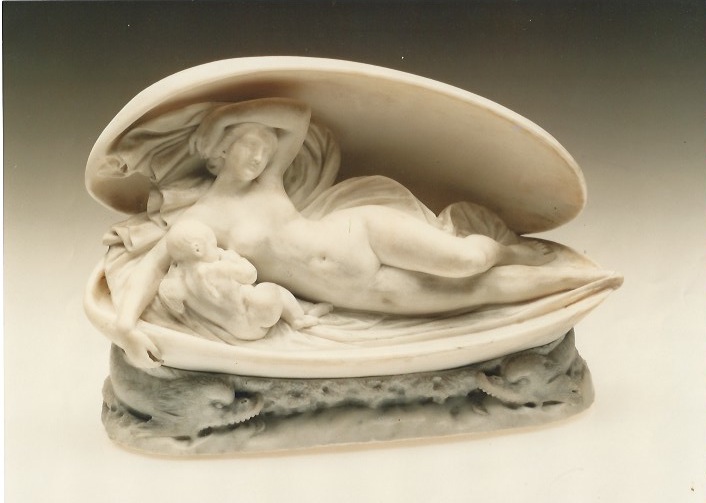
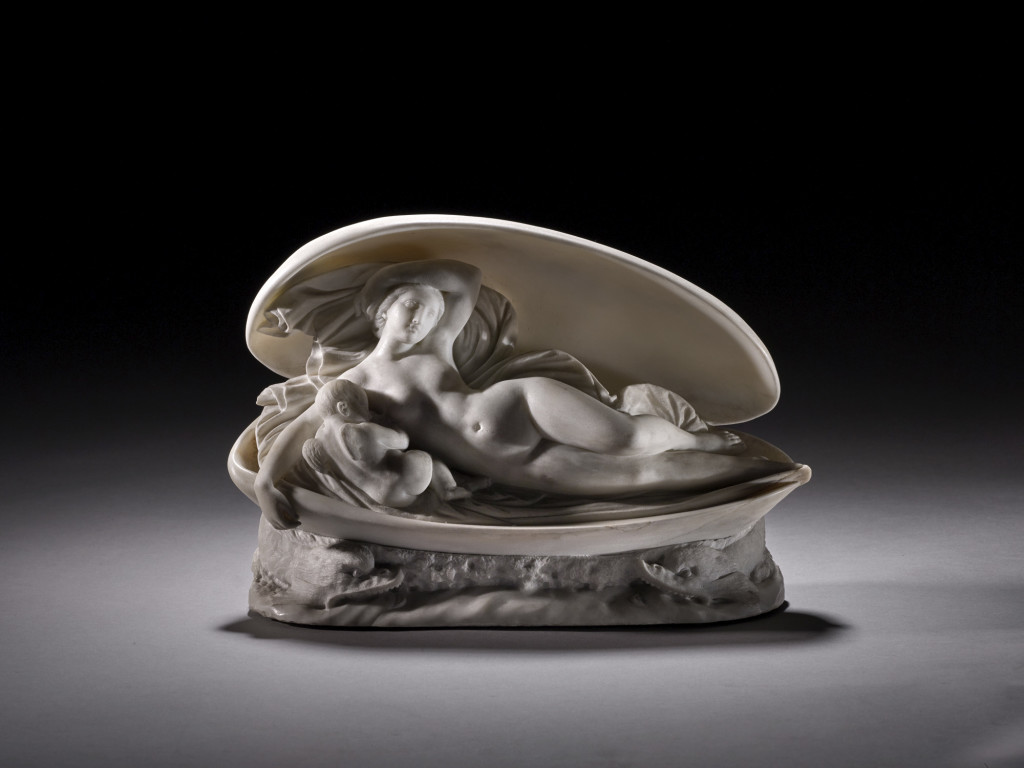
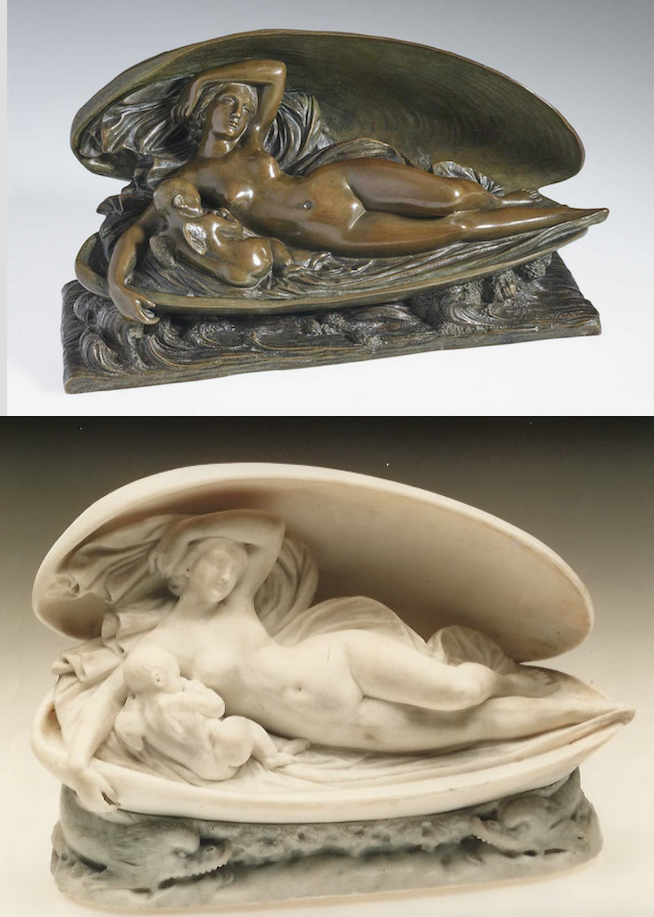
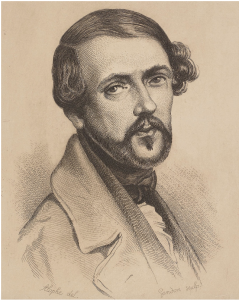
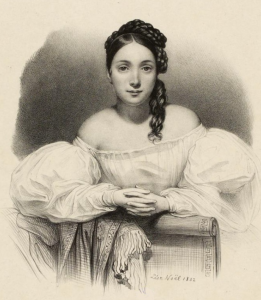
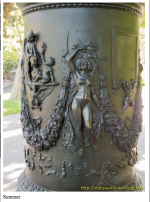
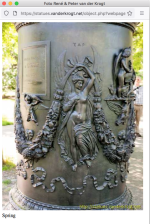
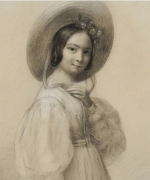

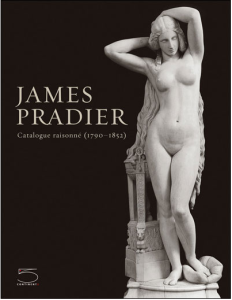
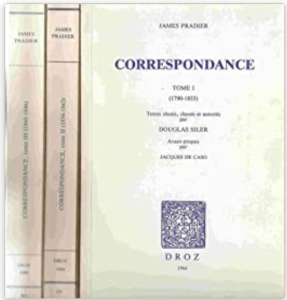

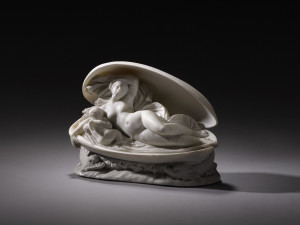
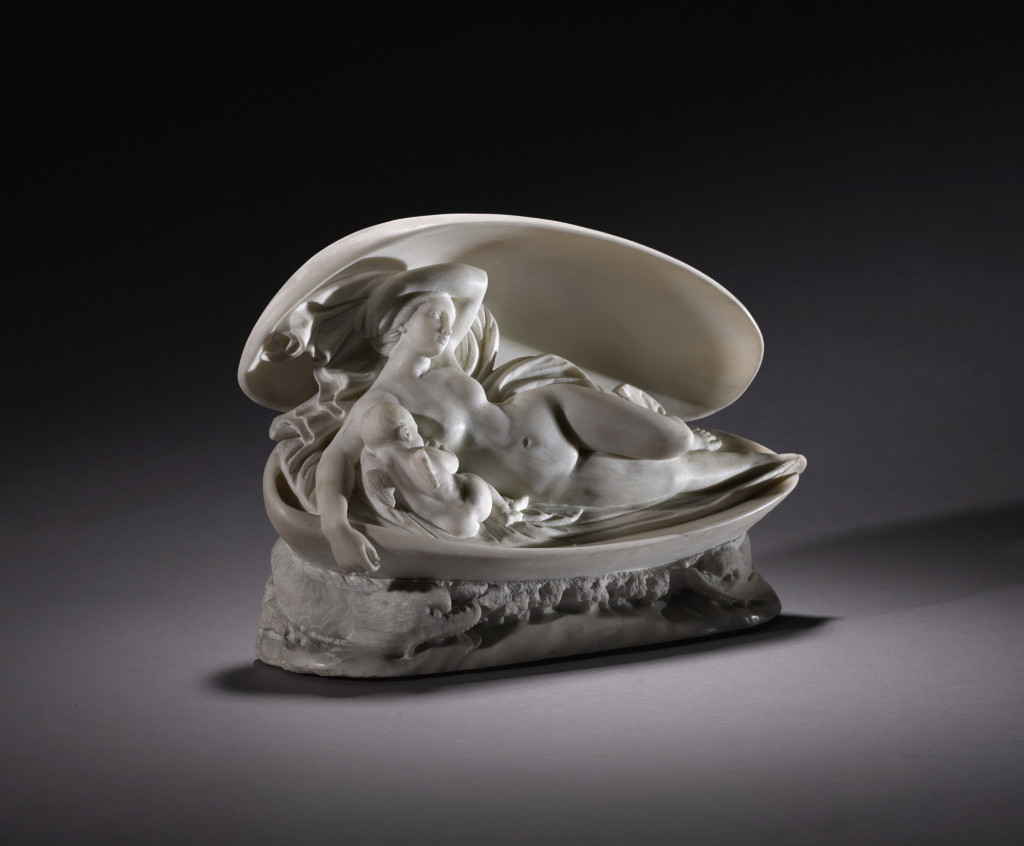
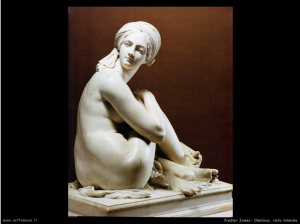
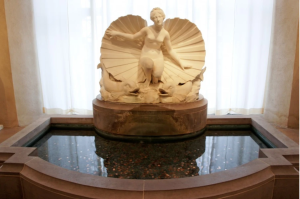
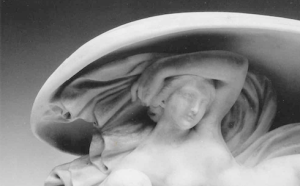
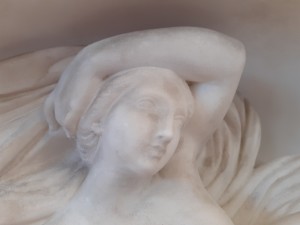
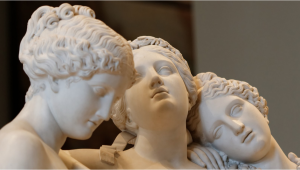
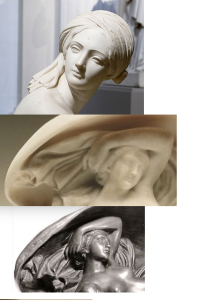
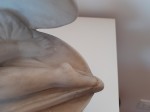

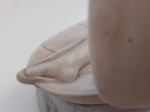

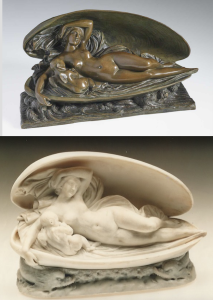
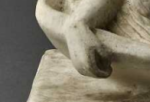
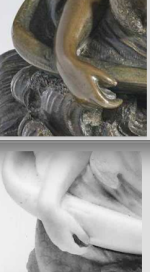
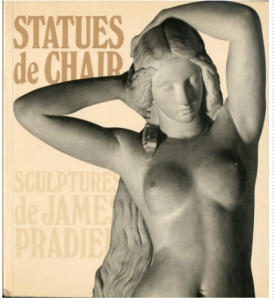
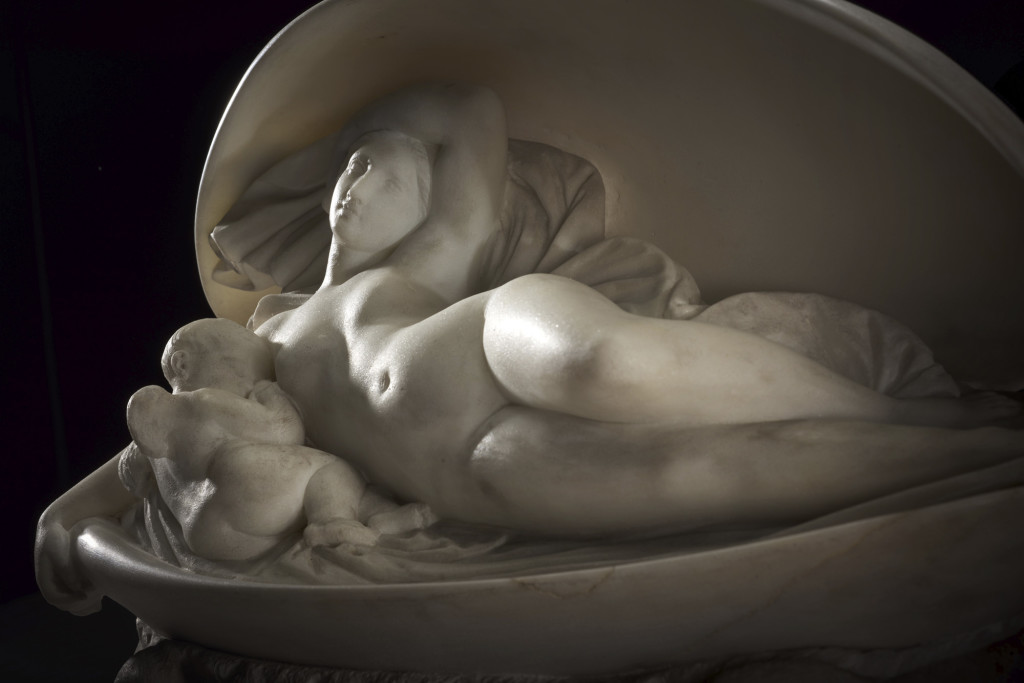
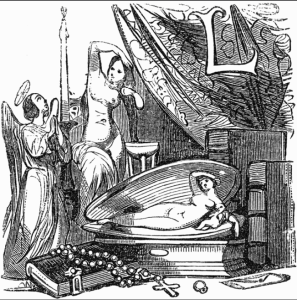
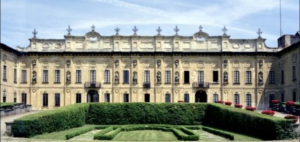
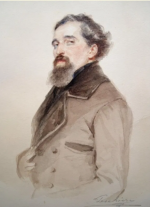

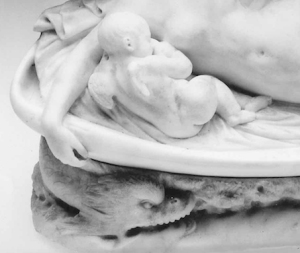
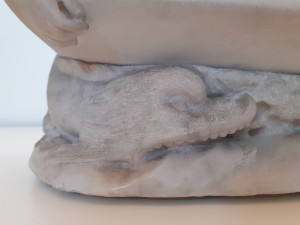
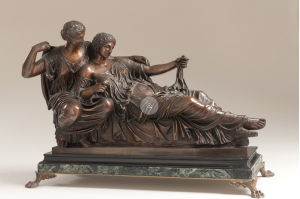
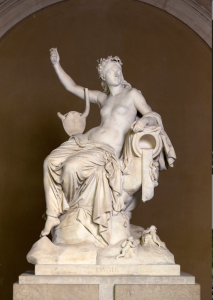
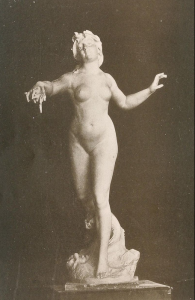
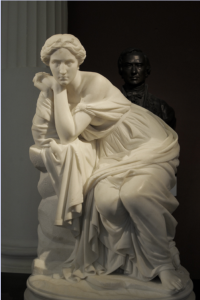
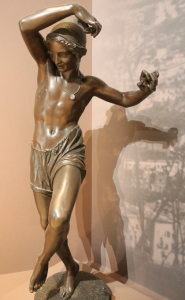

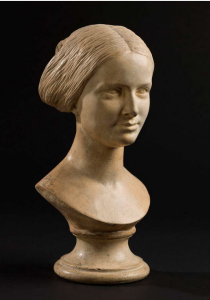
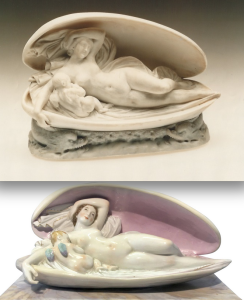
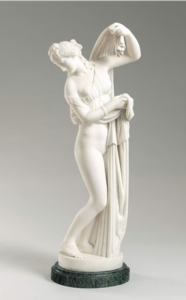
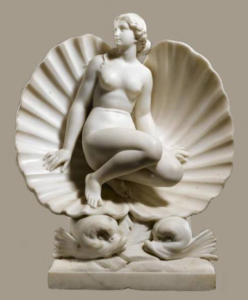
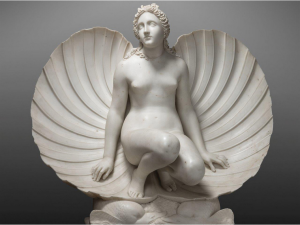

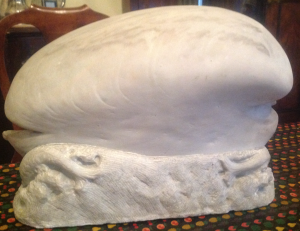
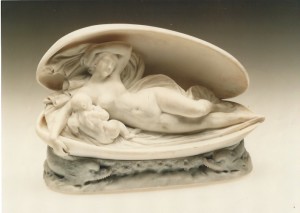
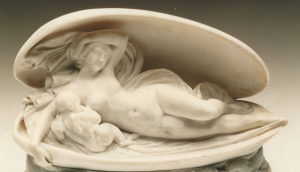

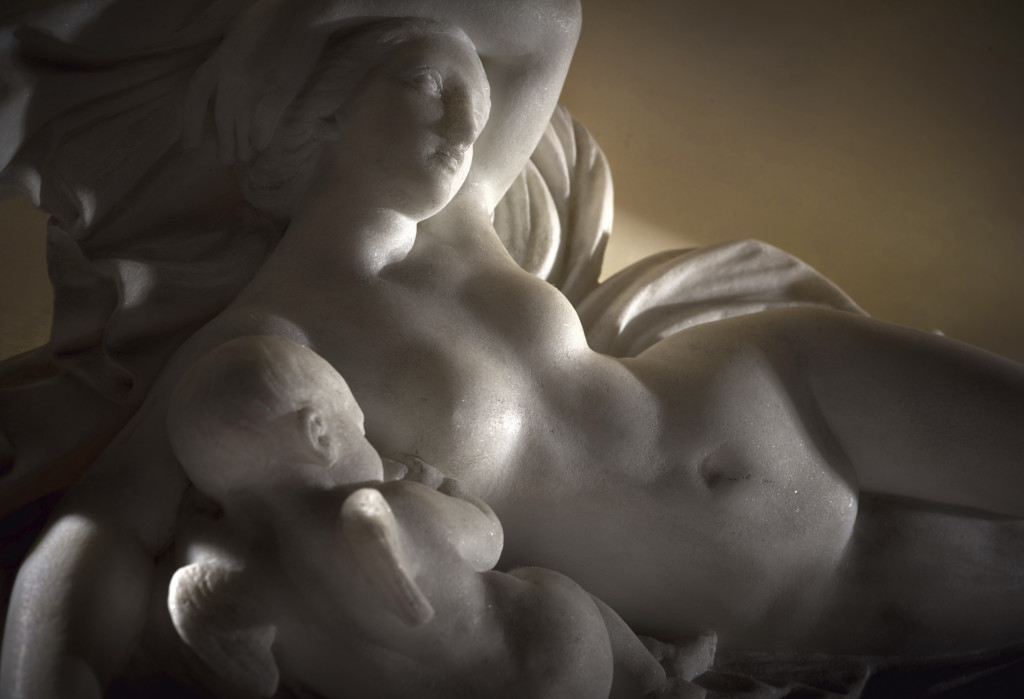


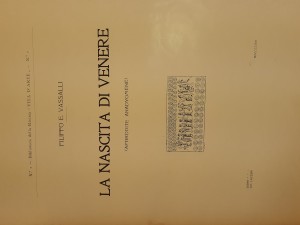
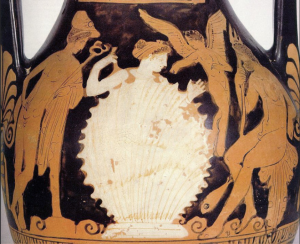

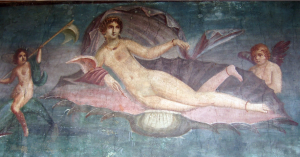
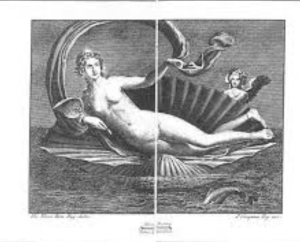
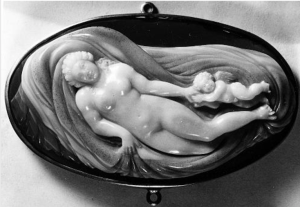
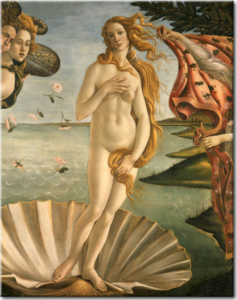
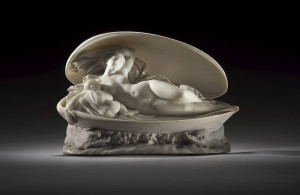
Dedicato a Claude Lapaire.
Claude Lapaire ha dedicato alla scultura di Pradier “La Naissance de l’Amour” un intero saggio
che si può facilmente leggere e gustare in rete su Forum Pradier.
Questo è il link : https://www.jamespradier.com/Texts/Venus_dans_une_coquille.php
Il saggio di Lapaire è veramente da ‘gustare’ – assaporare e godere – perché
oltre ad essere un esempio oggi rarissimo di studio appassionato e approfondito di un tema,
ricco di notizie inedite, di immagini straordinarie ed eloquenti e di una completa bibliografia,
è anche una lettura divertente, capace, quando meno te lo aspetti, di strapparti un sorriso.
Ho già espresso più sopra la mia riconoscenza per i suggerimenti di studio e di ricerca che mi ha regalato,
qui voglio ringraziare Claude Lapaire per i suoi imprevedibili spunti di elegante umorismo.
Come quando scrive : “I Pradier made-in-China sono arrivati !”
Chi ha vissuto in Francia ricorda il festoso annuncio che a partire dalla mezzanotte del terzo giovedì di Novembre
annuncia ogni anno : “Le Beaujolais Nouveau est arrivé”.
Però il 25 Luglio 2011 Lapaire insieme a Douglas Siler annuncia altrettanto festosamente :
“Les Pradier made-in-China sont arrivés’ ! “
La notizia è importante perché Pradier ci rivela che in Cina, nella regione del Quyang, provincia dell’Hubei
si contano 26.000 atelier che danno lavoro ad oltre 50.000 artigiani
e producono migliaia di repliche in bronzo e marmo – su misura, tu dici come la vuoi e loro te la fanno –
di scultura antiche e moderne.
Puoi ordinare la ‘Venere di Milo’, Michelangelo, Canova, Rodin e ovviamente anche i Pradier monumentali.
Non ancora per fortuna i piccoli Pradier, quindi non ancora la piccola conchiglia con “La Naissance de ‘Amour”.
Anche in Cina, soprattutto in Cina, ‘Business is Business’
e se il falso troppo piccolo rende troppo poco perché falsificarlo ?
Imperdibile poi Lapaire più oltre quando parla della ‘Fontana delle Api’, opere del Bernini a Roma.
Lapaire immagina che l’acqua della vasca, che in realtà è una grande conchiglia,
abbia accolto nei secoli più di una bellissima fanciulla che si sentiva Afrodite nella conchiglia.
Lapaire non lo dice, ma come non pensare a Fellini che avrà la sua stessa fantasia ?
Ed ecco una indimenticabile irresistibile Afrodite (Anita Ekberg)
che ci invita ad entrare con lei nell’acqua della Fontana di Trevi.
Scrive Lapaire “Non sveleremo certo qui delle novità di un erotismo spinto”,
ma non trascura di evocare l’assonanza tra ‘valva’ e ’vulva’ e,
nelle parole di Pradier stesso in una sua lettera del 1844,
la forma e persino l’odore del ‘luogo della grande generazione’.
‘L’origine del mondo’ non era ancora stato creata, (Courbet, 1866),
ma certo il profumo era già nell’aria.
Sono profondamente debitore a Douglas Siler, grande studioso di James Pradier, della sua vita e delle sue opere.
Douglas mi scrive e mi regala correzioni indispensabili e notizie esclusive.
Devo alla straordinaria cortesia di questo studioso e alla sua rarissima generosità di idee, suggerimenti e informazioni inedite
che di certo migliorano il mio saggio qui sopra “DI o DA Pradier ?”.
“DI o DA ?”
sintetizza la domanda fondamentale di questa ricerca che assomiglia a un “giallo”, a un classico romanzo poliziesco.
C’è un corpo del reato : chi ha commesso il reato ?
Chi ha scolpito questa “Naissance de l’Amour” in marmo ?
Il primo indagato è inevitabilmente Pradier stesso e ci sono molti indizi, come minimo 12,
che lo indicano come il protagonista di questo ‘giallo’.
Ma alcuni indizi non sono più così sicuri.
1
Il giorno di creazione dell’idea si sposta di 30 giorni in avanti.
C’è incertezza nella lettura del timbro sulla lettera di Pradier che descrive a Juliette come e quando è nata l’invenzione della Venere nella conchiglia.
Indiscutibile è l’anno, 1838; indiscutibile è il giorno, il 15 del mese; ma il mese potrebbe essere sia Luglio, sia Agosto.
Ho scritto : L’invenzione (non la realizzazione) di questa scultura in marmo ha dunque sia un autore sia una data certa :
James Pradier e 15 Luglio 1838 a Parigi. …
Douglas mi regala una preziosa precisazione : «Hélas, non, car la date de cette lettre n’est pas certaine.
Guimbaud la date du 15 juillet 1838 sur la base du cachet postal. Mais ce cachet postal est incomplet et difficilement lisible.
Ayant pu étudier ce cachet à la loupe après avoir acquis la lettre, j’y lis hypothétiquement le 15 août 1838.
L’original de cette lettre m’appartient. Je l’ai acquise trop tard pour la citer dans le tome II de la Correspondance de Pradier
où je rapporte seulement, p. 167, ce que Louis Guimbaud en dit dans un article sur JD.
Mais je compte la publier intégralement dans mon t. VI (Supplément). »
2
Il corpo del reato non è uno solo : forse sono due !
C’è un nuovo corpo del reato, un’altra “Naissance de l’Amour” in marmo,
di cui si è scritto, ma che nessuno ha mai visto (vedi nel saggio qui sopra il § 8).
Un testimone lo ha confermato, però nessuno l’ha mai visto !
Scrive Douglas : “Curieusement, Claude Lapaire ne mentionne pas ce marbre agrandi qui,
d’après J. de Caso, se trouverait dans une collection au Royaume-Uni.
Serait-ce le même que le votre, ou une autre réplique faite par le même sculpteur ?
En tout cas, son existence ne prouve ni n’exclut que le votre soit de la main de Pradier».
3
Nella lista degli indiziati bisogna aggiungere un nuovo nome.
Difficilissimo da trovare !
Se non fosse stato Pradier, CHI potrebbe avere scolpito questa “Naissance de l’Amour” in marmo ?
Nel mio testo qui sopra si propongono nomi di aiutanti di Pradier,
di suoi allievi, di editori a cui Pradier affidava la replica di sue opere,
e anche di altri scultori francesi e tedeschi e italiani che hanno sicuramente conosciuto sia Pradier sia le sue opere
e che forse ne hanno anche replicato alcune, forse persino in marmo.
Devo aggiungere però un nuovo indagato, praticamente irreperibile, ma fortemente indiziato.
E’ M. Dupuis,’praticien en Rue du Dragon, Paris. Lo indica come “indiziato” proprio Douglas Siler :
« Voici en premier lieu une réflexion qui sera sans doute la plus importante pour votre propos.
Vous écrivez dans votre argument n° 8 : Però mai Pradier consente il diritto di riproduzione in marmo,
sia perché probabilmente non era pensabile che accadesse,
sia perché non intendeva affidare ad altri la riproduzione in marmo di una sua creazione.
Visto che altri potevano riprodurre solamente in bronzo “La Naissance de l’Amour”,
allora potrebbe essere J-J. Pradier, e non altri, lo scultore che ha modellato in marmo
questa versione, più grande e con varianti, della sua originale “Naissance de l’Amour” in bronzo.
Or Pradier, pour autant que l’on sache, n’avait pas l’habitude de faire des reproductions en marbre de ses statuettes.
MAIS,
on a la preuve que, de son vivant, au moins un sculpteur – en fait, un praticien – semble en avoir exécuté plusieurs,
soit sous contrat avec lui, soit sans son autorisation.
Cette preuve se trouve dans l’inventaire établi après son décès en juin 1852
qui donne une description détaillée de tout ce qui se trouvait dans son appartement du quai Voltaire
ainsi que dans ses deux ateliers de l’Institut. Il contient aussi des déclarations faites par ses héritiers relatives à ses dettes et à ses créances.
Parmi ces déclarations figure celle-ci :
« Déclarations sur l’actif. Les parties déclarent qu’elle pensent [...] que la succession a des réclamations à faire
contre M. Dupuis, praticien, demeurant à Paris, rue du Dragon,
à raison de la reproduction en marbre par lui faite de diverses statuettes de M. Pradier. »
Cette déclaration est citée en partie par Claude Lapaire (p. 91). Naturellement, d’autres sculpteurs, non nommés dans l’inventaire,
ont pu faire des reproductions aussi, avec ou sans son accord, ou après son décès. On ne sait rien sur ce praticien Dupuis.
Mais il figure peut-être, avec son adresse de la rue du Dragon, dans les annuaires du commerce de Firmin Didot Frères,
en ligne dans la base Gallica de la BnF. Pour les consulter, il suffit de taper dans la barre de recherche Google
les mots « Gallica annuaire général du commerce » et de sélectionner ensuite une année parmi celles qui sont proposées.
Il est possible aussi de faire une recherche dans toutes les années simultanément, en une seule fois.
Malheureusement, le nom Dupuis est très répandu et, de plus, la base Gallica n’est pas toujours facile à utililser.
In sintesi Douglas Siler è sicuro : sulla sola base delle fotografie e allo stato attuale delle indagini
è assolutamente impossibile sia confermare sia escludere l’attribuzione di questa scultura alla mano di James Pradier.
Perciò grazie a questi preziosi suggerimenti l’indagine per scoprire chi sia l’autore di questa versione in marmo de “La Naissance de l’Amour”
non soltanto non è ancora risolta e forse non lo sarà mai, ma è anzi oggi ancora più stimolante e più affascinante per me.
Il mistero si infittisce.
Ma a fronte del mistero Shakespeare ci apre orizzonti infiniti di speranza : “A mari inesplorati, spiagge insperate”.
I contemporanei attribuivano a Pradier una capacità rara e forse unica : quella di fondere e confondere brillantemente
un’apparenza di antica armonia classica con una modernissima fibrillazione erotica.
Su di lui caustico il collega scultore Antoine-Augustin Préault (1809-1879) dice :
“Ogni mattina Pradier si mette in cammino verso Atene e ogni sera arriva a Bréda”.
Bréda era in quegli anni il quartiere a luci rosse di Parigi, dove abitavano e ricevevano le “Lorettes”.
Queste professioniste erano chiamate “Lorettes” perché abitavano accanto alla Chiesa Notre-Dame-de-Lorette, sacro e profano a portata di mano.
Effettivamente nel marmo della “Nascita dell’Amore” studiato nel saggio qui sopra,
la classica purissima bellezza del nudo di Afrodite distesa nella conchiglia
e il suo tenero gesto materno di stringersi al seno (nudo peraltro) il piccolo Eros,
non escludono, anzi forse suggeriscono, pensieri assai poco ‘platonici’ e molto sensuali.
“Of Pradier” or “From Pradier”?
To be or not to be Pradier.
Here is the problem with this marble “La Naissance de l’Amour”.
I love this sculpture.
I have been studying this sculpture for more than 50 years.
In these 50 years, experts, art historians, the most profound connoisseurs of Pradier’s art have seen, studied, caressed her.
Everyone agrees: it could be from Pradier’s hand.
The original idea is certainly from Pradier.
The date of its creation is written by Pradier: it is July 15 (or August) of 1838.
Pradier gave the title “La Naissance de l’Amour”.
And to date, this sculpture is the only marble version of “La Naissance de l’Amour” that has ever been seen and studied.
50 years of study and the intervention of 16 Experts have led to this result:
it is reasonable to ask whether this marble could be from Pradier.
Reaching a reasonable doubt is a good result, an excellent point of arrival. Even more is a great starting point.
Today it is certain that this marble is “FROM” Pradier, but whether it is “OF” Pradier “is waiting to be discovered.
Between the “OF” and the “FROM” there is an unexplored sea to navigate. In the face of the mystery
Shakespeare opens up infinite horizons of hope: “To uncharted seas, unexpected beaches”.
You too are invited to this adventure.
Aphrodite is lying inside a shell and little Eros hugs her breast. The shell, supported by two dolphins, floats on a stormy sea. This white marble sculpture – 35 x 20 cm, height 25 cm and weight 12.9 kg – it is evidently inspired by the bronze “La Naissance de l’Amour” by Jean-Jacques “James” Pradier.
The invention of this work is by Jean Jacques ‘James’ Pradier (1790-1852) and has a precise date: July 15, 1838. In fact, on July 15, 1838, Pradier writes a letter to Juliette Drouet.
Juliette Juliette is an actress, now Victor Hugo’s partner. But when she was 19 Juliette was Pradier’s model and lover, who portrayed her (maybe, but maybe not) in very sensual nudes. The two had a daughter, Claire and even now that Juliette is officially unofficial companion of Victor Hugo, who is also married, Pradier tells her about his day:
“I also thought of him (Victor Hugo) because when in bed, suffering from a terrible neuralgia, I created an open shell and inside there is Venus who has just given birth to Love. As soon as (this new sculpture) is melted, I want offer to Hugo the first proof and I want to cast a small bronze and send it to the Duke of Orleans, when the princess has given birth “.
The invention (not the realization) of this marble sculpture therefore has both an author and a certain date: James Pradier and July 15, 1838 in Paris. (On the “certain date” we are not even so sure, but if wrong, we are slightly wrong. In fact, Douglas Siler, who owns the Pradier’s original letter, writes to me: “Helas, not: car la date de cette lettre n’est pas certaine. Louis Guimbaud la date du 15 juillet 1838 sur la base du cachet postal. Mais ce cachet postal est incomplet et difficilement lisible. Ayant pu étudier ce cachet à la loupe après avoir acquis la lettre, j’y lis hypothétiquement le 15 août 1838).
For the study of my sculpture precious was the dialogue with Claude Lapaire who dedicated an entire essay to this work of art, entitled: “Vénus dans la coquille, deux statuettes de James Pradier, sources et posteritè”, on 20/6/2009, hereinafter referred to as “Lapaire 2009″ and available on the web on “Forum Pradier”, created and animated by Douglas Siler.
Claude Lapaire then published the catalog and fundamental monograph: “James Pradier (1790-1852) Et la sculpture francaise de la génération romantique” 5 Continents Editions, 2010, hereinafter referred to as “Lapaire 2010″
On Claude Lapaire I write at length with deep gratitude in the first comment at the end of this text.
Equally valuable is Douglas Siler’s still-in-publication work “Correspondance”, who also had the infinite kindness to read this paper of mine in drafts. Within a few hours Douglas Siler sent me an email full of corrections, suggestions and impeccable informations. In the second ‘Comment’ at the end of this text, I summarize the precious news that Douglas Siler has already given me and I will add the others he has promised to send me. I will never thank him enough!
My question is : this marble version of “La Naissance de l’Amour” could it be from the hand of Jean-Jacques “James” Pradier?
By Pradier:
The first hypothesis for an attribution is that whoever sculpted in marble this “Venus and Cupid in the shell” is Jean-Jacques ‘James’ Pradier.
It is he who came up with the idea, the so-called ‘invention’ of the work which he himself baptized “La Naissance de l’Amour”, it is he who modeled the clay or wax necessary for the subsequent casting, (Pradier modèle ses statuettes dans l’argile ou la cire), it is he who finished the first proofs obtained in bronze.
This “Naissance de l’Amour”, however, is achieved in a different material (marble and not wax or clay and subsequent plaster, used for a bronze casting), is sculpted with a profoundly different technique (‘to remove’ rather than ‘to pose’), it is larger than the original model and adds important variations, not present in the original work.
It is therefore not a trivial copy because whoever makes a replica does not modify the original model.
It is possible, but not proven, that Pradier has achieved as well as in bronze, also in marble, his invention of “La Naissance de l’Amour” and that therefore this marble sculpture is the work of James Pradier.
The first version, the one mentioned by Pradier in his letter of July 15 (or August) 1838, was necessarily a model for bronze casting, since it would have been quite problematic with “a terrible neuralgia” rough hammering or even just chisel a block of marble while lying in bed.
However, it cannot be ruled out that once the neuralgia has passed and given the success of the bronze casting, Pradier then decided to realize his ‘invention’ also in marble.
There are at least 12 arguments in favor of the attribution of this marble to James Pradier.
1 Pradier carves marble.
Pradier is a great marble sculptor. His works are regularly exhibited, admired and favorably reviewed at the “Salons” in the Louvre and are present in public places, museums and private collections in Europe. Pradier dedicates himself to monumental works, but also to smaller works, what Lapaire, Siler, de Caso and Garnier call “statuettes”. Pradier’s other marble sculptures are really very similar to this one and therefore it seems difficult to exclude a priori that this marble is by Pradier’s hand.
2 From marble to bronze.
Usually a work born in marble is replicated in bronze. Why is it done? The marble work was successful, but it is a unique piece. The artist wants to arrange more original (multiple) and then, after the marble, models and then cast bronze replicas.
For example (see Lapaire 2009) the Swiss artist based in Rome Heinrich Keller (1771-1832) creates a “Venus in the shell” in marble, signature and date – H. KELLER F / ROMAE MDCCC).
Then from his marble (“his” not “other’s”) he himself made seven replicas in marble and two in alabaster. After him, a certain Chiarelli cast more than 13 ‘reductions’ in bronze.
3
From bronze to marble.
However, the opposite path is also frequent, namely that from a bronze original the artist then decides to make a larger marble replica and possibly with variants.
If this “Naissance de l’Amour” is the autographed replica in marble of one of his ‘invention’ originally born in bronze, for Pradier it would certainly not be the only time this happens.
And it happens for precise operational and economic considerations.
See “Statues de Chair” page 133, first column, about Pradier’s sculpture “Odalisque”, of which there are both bronze and marble versions at the Musèe de Lyon since 1841. “It is difficult to definitively decide on the chronology of the bronze and marble versions. There is no evidence that the bronze work, of which versions of at least two different sizes are known, is, as mentioned, the reduced version of the marble exhibited at the 1841 Salon. According to the conviction of many critics who reviewed it on that occasion (including Théophile Gautier) this would be proof of a practice by Pradier, confirmed by the jurisprudence of the time, for which on some occasions Pradier would have ‘experimented’ in some way a subject (his’ invention) in the small format of the ‘statuette’ to see if he was successful before investing in the costs of a marble creation and facing, so to speak, the risks of the Salon ”. And again on the same page 133 at note 11: “In his lifetime the sculptor Pradier had ceded the right to reproduce his works to various publishers. Most of these were born in the dimensions of simple statutettes, and it was only after putting them on the market as moulages, that he (Pradier) decided to reproduce those that had obtained the most success on a large scale ”.
In summary, these texts confirm that it could happen, and did happen, that Pradier created in small dimensions and cast in bronze and put on the market some small sculptures of his “invention” and then decided to make the same invention in marble if the bronzes had been successful. Marketing research ante litteram.
Therefore this marble could be a hand sculpture of Pradier himself, marble replica of his invention of “La Naissance de l’Amour” given the immediate success (§ 10 further on) that the bronze work had collected.
4
Marble and bronze: two different arts.
The technique of sculpting in marble, “by force to remove” is profoundly different, both physically and conceptually, from the technique of modeling in bronze, “by way of posing”, first creating a model in clay or wax which is then destined for casting and then finishing and eventually patinating the bronze.
The differences between this marble version of “La Naissance de l’Amour” compared to the bronze versions can be justified by the different results that the same artist obtains when he creates with marble, therefore ‘to remove’ compared to when he created the model for a bronze casting, therefore by ‘way of placing ‘.
It’s true: there are minimal differences between the bronze versions and the marble version de “La Naissance de l’Amour”, but these differences are widely explainable with the two different techniques of creation:
the two moments of processing are different;
different places to work (a marble requires you to work in a large studio, if desired, wax can also be modeled, as Pradier writes, while lying in bed or in any case in a room at home);
different times for the realization (minutes, maybe hours for a wax model; hours and maybe days for a marble); finally, the possibility that assistants or pupils intervene in a marble is different for a first roughing of the boulder, while this does not happen modeling wax or clay for a bronze.
There is a further consideration to be explored on the difference in execution of the same idea – born for example from a quick sketch or an accurate drawing by the artist – in marble or bronze. There is a profound difference both in the construction phase and in the selling price. For those who buy it, a marble sculpture is inevitably more expensive than a bronze sculpture, replicas of which already exist or may in the future exist (multiple) which therefore decrease the uniqueness and rarity of the work. This higher cost reduces the number of potential buyers a few patrons and the State or Public Commissions.
For the artist, the monumental marble sculpture involves high production costs and fewer sales opportunities. On the other hand, small sculptures – the ‘statuettes’ – cost the artist much less and are accessible to a wider market. Marketing strategy ante-litteram.
Pradier’s statuettes are in fact immediately appreciated both in the galleries of private art collectors for their seductive and mischievous inventiveness, both in the boudoirs and in the pied-à-terre of gallant connoisseurs for the elegant and refined erotic echoes (Guillaume Garnier in “Statues de Chair” page 246, first column).
5
Marble and bronze: two similar sculptures.
However, there are much more obvious similarities than the differences between this marble sculpture, the bronze versions of the same subject and also with other James Pradier marble sculptures: (see photos on
http://www.francobellino.com/?p=4336#more-4336
… characteristic and recurring anatomical details (the motifs-initials or ‘numbers’ of Giovanni Morelli) in his art.
These points of undeniable contact lead if not to confirm at least not to exclude a single paternity both for the bronze ‘statuettes’ and for this marble: the hand of James Pradier.
6 In marble the dolphins, in bronze no.
The presence of the two dolphins in this marble “La Naissance de l’Amour”, dolphins that are missing in all the bronze versions, but they are present in the vertical “Venus in the shell” also by Pradier, around 1840 deserves attention.
It is rare for those who replicate another artist’s famous work to take risks to modify the work that he is copying and insert elements in its copy that are not present in the original being copied.
Why should he do that if his goal is the faithful reproduction of an original and already famous model? Whoever makes the copy knows that the recipient (client or potential buyer) of his replica wants a faithful reproduction and not a variation on the theme.
The presence of the two dolphins in this marble sculpture – dolphins that are missing in all the bronze versions of “La Naissance de l’Amour” makes think more to the work of an artist who creates, than to the work of someone who replicates a famous work.
It therefore seems more logical to think that James Pradier – given the success of his first two bronze castings – has also decided to create a new version in marble. Moving on to such a different material (from the warm malleability of wax or clay to the cold and hostile hardness of the marble block) and to a profoundly different sculpture technique Pradier then decided to modify the size of the original sketch, to sculpt a more majestic and more imposing marble than the first two bronzes, which Lapaire calls ” statuettes “.
And above all it is possible that Pradier has decided to add some variations – the stormy sea and the two monstrous dolphins – precisely to emphasize the authorship and originality of this ‘variation on the theme’.
It is therefore inevitable at least to ask: could it be James Pradier the sculptor who modeled this version, larger and with variations in marble, of his original bronze “Naissance de l’Amour”?
7
“It is forbidden to reproduce me in marble”.
Pradier has always given precise instructions and limitations on the possibility of making replicas of his works: (cf. Lapaire) “… Pour la Venus à la coquille Salvatore Marchi … avait le droit de reproduction en bronze seulement “. Elsewhere Pradier states: “A vendre le droit de reproduction en bronze seulement”, or also “le droit de reproduction en plātre”.
Oddly, Aphrodite’s right hand in the Geneva plaster cast it is much more like the hand of my marble (note the different inclination of the thumb!) than with the hand of bronze. Yet the plaster should be a faithful copy of an original model: one might think then that the gypsum is it a copy of the marble and not the bronze of “La Naissance de l’Amour”?
But Pradier never allows the right of reproduction in marble, both because it was probably unthinkable that this would happen, and because he did not intend to entrust to others the marble reproduction of one of his creations.
Since others could only reproduce “La Naissance de l’Amour” in bronze, then it could be J-J. Pradier, and not others, the sculptor who modeled in marble this version, larger and with variations, of his original bronze “Naissance de l’Amour”.
8
In the texts only a marble. Never seen though.
In addition, Lapaire also writes: “La Naissance de l’Amour” est restée pratiquement sans postérité bien qu’elle ait eté largement diffusée par l’edition. Les sculpteurs semblent ne pas l’avoir copiée. ”
On the one hand, it would seem that, apart from the sculpture being studied here, no other marble version of “La Naissance de l’Amour” is known.
On the other hand, on 2 December 2019 Douglas Siler wrote to me: “Jacques de Caso l’a également étudiée, brièvement, dans le catalog de l’exposition ‘Statues de chair’ (Genève et Paris, 1985-1986). Splendid catalog of the exhibition first in Genève at the Musée d’Art et d’Histoire (October 1985 – February 1986) and then in Paris, at the Musée du Luxembourg, (February-March 1986).
The volume includes writings by C. Lapaire, J. de Caso, D.Siler, G. Garnier, I. Leroy-Jay Lemaistre.
There, dans une note sur les différentes versions connues de l’oeuvre, De Caso mentionne qu’il “s’en trouvrerait une, agrandie, en marbre, dans une collection anglaise”.
If, as Lapaire writes, “no one has ever copied it” in marble and if, as de Caso writes, perhaps a marble replica would be in a private collection in the UK, why exclude a priori that my sculpture is by Pradier’s hand ?
9
In the auctions never seen in marble.
The Pradier Forum (www.jamespradier.com) registers Pradier’s works under “Ventes”, appeared in auctions worldwide in the years between 2003 and 2017 and also some other off-auction proposals.
The web and Sotheby’s have registered hundreds of Pradier’s works appeared in Auctions since today.
Never “La Naissance de l’Amour in marble” !!!
Out of hundreds of proposed lots, sometimes awarded and sometimes not and repeatedly resubmitted even after a few months, there is not a single one that represents “La Naissance de l’Amour” in marble.
There were 6 bronze versions, in the years 2008-9-14-15 and 16; a plaster version painted in 2011; one in bisque in 2010 and even one in ivory in 2016. But never a version of “La Naissance de l’Amour” in marble!
Perhaps this fact means something: first of all it confirms what Claude Lapaire writes above that “La Naissance de l’Amour” no one has ever copied it in marble.
Furthermore, the fact that this version in marble seems to be today a ‘unicum’ in the vast literature on Pradier, could reinforce the thesis that this sculpture can be not only FROM Pradier, but also OF Pradier.
10
Immediate success.
The “Naissance de l’Amour” is immediately so loved and famous which already appears – just two years after its ‘invention’ – in an 1840 volume ‘Les Français peints par eux-même’, as present in the WunderKammer of a hypothetical “Chanoinesse”.
The image, even if mirrored, as always happens in graphics, is indisputable and the Pradier’s sculpture evoked and represented here could very well be a marble and not a bronze.
Moreover, Siler points out to me, not only the Aphrodite in the shell is indisputably the work of Pradier, and represented so white and dazzling it could very well be a marble and not a bronze. but the other sculpture in the illustration in the center is also by Pradier: “Juste. A noter que la statuette debout est La femme se lavant les cheveux de Pradier, qui date de 1840 – cat. Lapaire, n ° 146.) ” We are still in 1840. Gustave Flaubert has to ‘furnish’ the apartment of one of his young protagonists who, in love with the wife of an art dealer, squanders the money he doesn’t have on paintings and sculptures. And here is the apartment that the young man shares with a poor friend like him: “… a view of Venice, one of Naples, one of Constantinople … and a group of Pradier on the mantelpiece ”. (Gustave Flaubert “L’éducation sentimentale”. Première partie. Chapitre V) “Un groupe de Pradier sur la cheminèe” certainly cannot be a monumental sculpture: much more likely it is one of his ‘statuettes’, which were immediately so famous. And since the young people in that room just before spoke of “many Venus”, why not think that Pradier’s sculpture on the fireplace is it perhaps – and I stress perhaps – the marble of “La Naissance de l’Amour”?
11 Prestigious origin
The provenance of this marble sculpture is of great prestige. It was purchased in the 1970s at Villa Crivelli villa Crivelli just when they were dispersed by the last heir of the Crivelli family the ancient paintings and sculptures of a famous collection appreciated by illustrious visitors: from Carlo Goldoni to Antonio Canova and Giuseppe Bossi, Stendhal Alessandro Manzoni). provenance: “Villa Crivelli in Arese”. probably this villa is: Villa Arconati known as “Il Castellazzo” in Castellazzo di Bollate (Milan) https://it.wikipedia.org/wiki/Villa_Arconati inhabited by Vitaliano Crivelli (1806-1873) collector of neo-classical art and finally sold by Vitaliano Crivelli, 9th Marquis of Agliate, in the 1970s.
12
Wealthy collector buys originals.
The presence of a copy in a famous collection does not make much sense. Why on earth Vitaliano Crivelli, a very rich, cultured and well advised collector, should have bought for his famous collection the replica of a famous sculpture, but different from the original because it is made of a different material (marble instead of bronze), of different sizes (much larger) and with iconographic variants (dolphins) not present in the original, when could he have easily bought an original? It would seem more logical to assume that the famous and cultured collector has procured an original for his collection, by the hand of the artist who created the invention of the “Naissance de l’Amour” instead of a copy by an unknown sculptor. He may have sought and obtained the only existing original of a work already very famous in Europe, however, the work was only available in bronze, but never in marble. For a refined collector without economic problems, the rarity and uniqueness of a work they are a goal that justifies any expense.
However, there is also an authoritative opinion against attributing to James Pradier the realization of this marble sculpture. A long dialogue via email with Professor Claude Lapaire and his examination of many photographs of this marble, but never of the original marble and therefore never with the possibility of seeing it from life, touching it, caressing it and studying it thoroughly, bring Claude Lapaire to write to me:
Cher Monsieur,
vos nouvelles photos me permettent de mieux comprendre votre marbre …
Pradier a fait faire par ses praticiens un très petit nombre de réductions en marbre
de ses grandes statues. …
Du vivant de l’artiste, ou plus tard, avec l’accord de ses héritiers,
aucune autre statuette de Pradier n’a été reproduite en marbre…..
votre Naissance de Vénus me paraît une réplique légèrement agrandie
et soigneusement exécutée de l’original de Pradier,
intelligemment modifiée par l’adjonction des deux dauphins.
Je ne suis pas à même de dire quand et où ce marbre a été taillé,
mais certainement pas par Pradier ou ses collaborateurs.
Claude Lapaire
Claude Lapaire writes me these lines on 5 December 2019.
Perhaps today some of the 12 arguments I have proposed above to support the possibility (not the “certainty”: the possibility!) that this marble sculpture is the work OF Pradier will be able to convince Claude Lapaire and Douglas Siler and Jacques de Caso and some passionate readers of the Pradier Forum.
Perhaps my 12 arguments may not say persuade, but at least raise the doubt that this marble version of “La Naissance de l’Amour” – the only one known to date and documented with photographs, detailed comparisons with the bronze and with other works by Pradier, with provenance and history of his collecting path – may be (not “is”: may be) not only FROM Pradier, but OF Pradier. Or maybe not. But in any case it was nice to study this sculpture, it was interesting and instructive to attend the Pradier Forum, it was exciting to discover the kindness and availability of great experts such as Claude Lapaire and Douglas Siler, people of a humanity and cultural elegance that are now very rare. And it will certainly be exciting to read the opinions of all those who love James Pradier like me and his ‘invention’ of “La Naissance de l’Amour” The dialogue with Professor Lapaire is still ongoing and I await from him the reasons that led him to his decision: what are the details, the significant details that lead him to exclude the hand of James Pradier and his atelier from this marble. Douglas Siler tells me that from the photos it is impossible to both confirm and exclude the attribution of the work to James Pradier. Of course, the ideal would be to bring the marble to Geneva or to host Claude Lapaire and Douglas Siler in Venice: who knows that won’t happen.
Until then, however, the attribution of “La Naissance de l’Amour” in marble to James Pradier remains one of the possible research hypotheses, perhaps the most probable, but it must also be extended the search for other names, other dates and different locations, compared to Paris.
From Pradier :
If this marble version of “La Naissance de l’Amour” is not of Pradier, today there is no longer any doubt that it is from Pradier. This has not always been the case: for years many have seen and studied it without discovering that it has its own indisputable iconographic source and also a certain date for its invention (James Pradier’s letter of 15 July 1838). In this new line of research then the problem becomes: if this marble sculpture is not by Pradier, WHO carved it? and where ? and when ? and WHY copy a famous sculpture, but modify it? To answer these new questions we need to identify a sculptor that is not a trivial ‘replicant’. This sculptor to be identified is certainly a gifted artist of great talent and refined manual skills. He cannot be an Academy student, he cannot be a ‘copyist’ who works to order. Whoever sculpted this marble must be an original author, who can also decide to be inspired by someone else’s work, but is brave enough to dare to change an already famous model, the work of a very well known and appreciated artist.
For example, in this marble it is even more emphasized than in the bronzes the contrast between front and back: the frontal vision of a dazzling finitude, on the other hand the posterior view deliberately left and exhibited unfinished with evident traces of chisel blows. But there is more: the original expression of a strong contrast is evident in the marble between beauty vs monstrosity, between Humanity vs Nature: Humanity, fascinating in the female nude and tenderly affectionate in the gesture of little Love opposite to a threatening Nature (the stormy waves) and inhabited by sea monsters (the dolphins frankly much more ugly and unlikely of the elegant and cute animals they should represent). delfino fb and delfino f best comparison bronze – marble This marble is therefore not a replica, but the original invention, of an artist not yet identified, who may be a sculptor which he creates with marble between 1838, date post quem, because it was dictated by Pradier’s own letter, and 1873, the date ante quem and because 1873 is the year in which Vitaliano Crivelli died, which then ends the acquisition of works of art for his collection. The second half of the 19th century is also a confirmed date by various scholars, who have never referred to Pradier. Before identifying the 1838 bronze of Pradier’s “La Naissance de l’Amour”, for years I have shown my sculpture and sent photographs to various scholars and experts in 19th century sculpture. Vincenzo Vicario, Anthony Ratcliffe of the Victoria & Albert Museum, Carlo Ludovico Ragghianti, Raffaele Monti, Eugenio Riccomini. Everyone, always very kind and helpful, offered me their interpretation of this marble. For all the dating was the second half of the 19th century, although it varied from time to time the attribution to an artist.
Who is this unidentified sculptor for now, whose work is made before 1873, it is a question for now, but not forever, without an answer. Working hypothesis for an alternative attribution to James Pradier:
1
He is a young gifted French sculptor who perhaps participates in the nominations for a stay at Villa Medici for the ‘Prix de Rome’. This sculptor may have decided to replicate a work already famous in France, because he wants to show himself not only gifted with extraordinary technical skill in marble processing, but also capable of creativity, contributing to the work known to all remarkable personal innovations. Artists to study are certainly the more than 20 known students of Pradier. Between these : Eugène-Louis Lequesne (1815-1887) in Pradier’s studio from 1841 Eugène Guillaume (1822-19095) with Pradier from April 1841 Célestin-Anatole Calmels (1822-1906) Eugène Gonon (1814-1891) author of the manuscript essay “The art of casting lost wax bronze” (1876), creator of lost wax castings for Pradier and a sculptor himself. Aubin (1822-1895) from whom Pradier commissioned a marble sketch in 1841 of “Venus and Cupid” today at the Hermitage: is it Aubin Antoine Durenne? Founder and sculptor too? Nicolas-Victor Vilain (1818-1893) author of a sensitive portrait of Claire, daughter of Pradier and Juliette Drouet
2
He is a young German sculptor In those years Pradier’s “Naissance de l’Amour” was known in Germany. The work is already so famous and loved that the Royal Porcelain Manufactory of Berlin (Königliche Porzellan-Manufaktur Berlin) decided to produce reproductions in painted porcelain and with a documented trademark in the years between 1837-1844. KPM comparison A German sculptor not yet identified, whether he has seen Pradier’s bronze originals or engravings reproducing them, whether you’ve just seen the KPM porcelains that make them popular, but misrepresenting the spirit (Venus with face powder and lipstick!) decides instead to give his own interpretation of that work, sculpting a marble, of different sizes and with their own personal additions.
3
He is an Italian sculptor, perhaps working in Rome. Between September 1841 and March 1842, therefore a few years after the creation de “La Naissance de l’Amour”, Pradier spent a long time in Rome together with some young students, Guillaume and Lequesne. In Rome Pradier works in his atelier, has important commissions and (writes Lapaire) “Has contacts with the quarrymen of Carrara marble”. If he has contact with marble quarrymen, it is likely that he also carved in marble. In recent months Pradier has certainly also had contacts with the Italian artistic environment, therefore also with other sculptors active in that period in Rome. Nor can it be excluded that Pradier has with him, or finds in Rome, some replicas of his original bronzes of Venus in the shell. Some Italian artist could then decide to replicate in marble, with their own variants, Pradier’s work. This Italian sculptor could be:
3.1 Gaetano Rossi (1829- )
A little bronze statue (about 15 x 12 cm compared to 35 x 25 cm for the marble), seen in the 1970s from an antique dealer in Rome, in via dei Coronari and unfortunately not photographed, perhaps it perfectly replicated Pradier’s bronze or perhaps this very marble. The bronze was signed on the back “G. de Rossi in Rome ”and then if the author of the bronze was Gaetano Rossi, who signed himself “G. de Rossi in Rome “, then he himself could be the author of this marble. Gaetano Rossi’s marbles are documented, many similar to this one.
The very name of Gaetano Rossi suggested Vincenzo Vicario, author of the monumental work in 2 volumes “The Italian sculptors from Neo-classicism to Liberty”, writing to me on May 19th 1994: “… your” Venus belongs to the second half of the nineteenth century, moreover, I would say at the beginning of this period, that is, about the first decade from 1850. I think your sculpture can be attributed to the Neapolitan Gaetano Rossi … he was a portraitist, but above all a performer of genre sculptures, such as … “Venus” … he devoted himself mainly to making copies of the ancient statues … ” Eugenio Riccomini who wrote to me in 1991: “… Your delicate statue seems to me to have little to do with Giacomo Rossi from Bologna which I studied at the time and who was more daring and fiery. Among other things, it seems to me that your work is of a later date, already advanced in the nineteenth century. ” Strangely all the Italian and English experts consulted before I discovered Pradier’s bronze, however, they had not identified in “La Naissance de l’Amour” created in 1838 by James Pradier, the original invention of this image to which the marble inevitably draws inspiration even though it then proceeds to notable variations. In this ‘mystery’, however, the search for the person responsible for the ‘body of the crime’ proposes today a new suspect: Carlo Finelli (1785-1853) sculptor in Rome.
3.2 Carlo Finelli (1785-1853) “… His father, descended from a family of sculptors, initiates him into art from an early age. … Between 1814 and 1815, Carlo Finelli begins to sculpt a series of works of mythological subject, including Venus rising from a shell Finelli 2 and Psyche and the Dancing Hours, inspired by Canova’s three Graces … Still, in these years Finelli found himself grappling with numerous works commissioned from him by important personalities, especially English and Russian…. From the period 1825-1830 are the works Venus collecting the clothes, Love with butterfly and Shepherdess with Flowers, performed for the Duke of Devonshire … He died in his Rome studio in 1853. ” These dates, the biographical information and the very few of his works found to date, suggest to dedicate a more in-depth investigation also to Carlo Finelli, of whom Lapaire already publishes a “Venus in the shell” very close to the marble we are investigating.
Summary of the opinions collected in the years preceding the identification of the original Pradier bronze. Written opinions are available in original:
1 Anthony Radcliff (Victoria & Albert Museum) from photographs verbal communication 17.2.1984 – “Most likely Milan, 1850 no later than 1870, school or circle of Raffaele Monti (1818-1881)
2 Carlo Ludovico Ragghianti from photographs, verbal communication by Raffaele Monti who studied sculpture in Milan and agrees with Ragghianti’s opinion: “Neo-classical iconography, late 1700s. The piece can be academic or even the early twentieth century “.
3 Eugenio Riccomini, from photographs – autograph communication 1991. “… Your delicate statue seems to me to have little to do with Giacomo Rossi from Bologna which I studied at the time and who was more daring and fiery. Among other things, it seems to me that your work is of a later date, already advanced in the nineteenth century. ”
4 Vincenzo Vicario author of “The Italian sculptors from Neo-classical to Liberty”, from photographs – autograph communication May 19, 1994 – “.. it belongs to the second half of the nineteenth century, moreover I would say at the beginning of this period, that is, about the first decade from 1850. ”
Bronzetto in Rome: in the 1970s an antique dealer in Via de ‘Coronari in Rome proposed a perfect replica of this marble, however in bronze and smaller (about 15 x 12 cm against 35 x 25 of the marble), signed “G. De Rossi in Rome ”on the back of the shell.
KPM porcelain Berlin 1837-1844 the painted porcelain is produced by KPM Directed Porcelain Manufactory of Berlin Königliche Porzellan-Manufaktur Berlin KPM used this scepter and eagle mark in the period: 1837-1844. Or maybe 1849-1870. Porcelain, if only for the way it is painted, seems to reproduce and evoke a marble sculpture and not a bronze sculpture. comparison KPM.png In summary . if KPM Berlin porcelain reproduces bronze, it is known that the bronze dates back to 1838 and the following years; but if the porcelain reproduces not bronze, but marble which is unknown to all today, then marble so that a German ceramic artisan could know and model it it must be prior to 1844 or in any case carved in the period 1837-1844.
Agenda : Other research needs to be deepened on the collaborators to whom Pradier entrusted the reproduction of his works. They own smelting workshops, including: Salvatore Marchi, Hèbert frères, Bonnet, Honorè and then Eugène Gonon and others. It is also necessary to look for a catalog of the Villa Arconati art collection and a catalog of the dispersion of the collection at auction in the 60s-70s of the last century. Research on this marble sculpture is currently underway both in Switzerland (C.L.), both in Belgium (D.S.) and in Italy. It is therefore appropriate for the moment postpone any decision on the attribution and dating of the sculpture. (continues) The following text has only personal relevance, but adds nothing looking for “La Naissance de l’Amour” in marble that is the subject of this study both by Pradier and, if not, by who it could be.
Dedicated to Claude Lapaire.
Claude Lapaire dedicated an entire essay to Pradier’s sculpture “La Naissance de l’Amour” which you can easily read and enjoy online on Forum Pradier. This is the link: https://www.jamespradier.com/Texts/Venus_dans_une_coquille.php Lapaire’s essay is truly to ‘taste’ – savor and enjoy – because in addition to being a very rare example today of passionate and in-depth study of a theme, full of unpublished news, extraordinary and eloquent images and a complete bibliography, it is also a fun reading, capable, when you least expect it, of making you smile. I have already expressed above my gratitude for the study and research suggestions that he has given me, here I want to thank Claude Lapaire for his unpredictable cues of elegant humor. As when he writes: “The Pradier made-in-China have arrived!” Those who have lived in France remember the festive announcement that from midnight on the third Thursday of November announces every year: “Le Beaujolais Nouveau est arrivé”. But on 25 July 2011 Lapaire together with Douglas Siler announced just as joyfully: “Les Pradier made-in-China sont arrivés’! ” The news is important because Pradier reveals that in China, in the Quyang region of Hubei province there are 26,000 ateliers that employ over 50,000 craftsmen and they produce thousands of replicas in bronze and marble – made to measure, you say how you want it and they make it for you – of ancient and modern sculpture.
You can order the ‘Venus de Milo’, Michelangelo, Canova, Rodin and of course also the monumental Pradiers. Luckily not yet the little Pradier, so not yet the small shell with “La Naissance de ‘Amour”. Also in China, especially in China, ‘Business is Business’ and if the fake too small makes too little why falsify it? Then Lapaire is not to be missed when he talks about the ‘Fountain of the Bees’, works by Bernini in Rome.
Lapaire imagines that the water in the tub, which is actually a large shell, has welcomed over the centuries more than one beautiful girl who felt Aphrodite in the shell. Lapaire does not say it, but how can we not think of Fellini who will have the same imagination as him? And here is an unforgettable irresistible Aphrodite (Anita Ekberg) who invites us to enter the water of the Trevi Fountain with her. Lapaire writes “We will certainly not reveal here the novelties of a pushed eroticism”, but does not neglect to evoke the assonance between ‘valve’ and ‘vulva’ and, in the words of Pradier himself in a letter of 1844, the shape and even the smell of the ‘place of the great generation’. ‘The origin of the world’ had not yet been created, (Courbet, 1866), but certainly the perfume was already in the air.
Dedicated to Douglas Siler
I am deeply indebted to Douglas Siler, a great scholar of James Pradier, of his life and works. Douglas writes to me and gives me essential corrections and exclusive news. I owe to the extraordinary courtesy of this scholar and to his very rare generosity of ideas, suggestions and unpublished information which certainly improve my essay above “OF or FROM Pradier?”.
“OF or FROM?” summarizes the fundamental question of this research which resembles a “detective story”, a classic detective novel. There is a body of crime: who committed the crime? Who carved this “Naissance de l’Amour” in marble? The first suspect is inevitably Pradier himself and there are many clues, at least 12, which indicate him as the protagonist of this ‘thriller’. But some clues aren’t so sure anymore. 1 The day of creation of the idea moves forward 30 days. There is uncertainty in reading the stamp on Pradier’s letter that describes to Juliette how and when the invention of Venus in the shell was born. Indisputable is the year, 1838; indisputable is the day, the 15th of the month; but the month could be either July or August. I wrote: The invention (not the realization) of this marble sculpture therefore has both an author and a certain date: James Pradier and 15 July 1838 in Paris. … Douglas gives me a precious clarification: “Hélas, non, car la date de cette lettre n’est pas certainine. Guimbaud la date du 15 juillet 1838 sur la base du cachet postal. Corn cachet postal est incomplet et difficilement lisible. Ayant pu étudier ce cachet à la loupe après avoir acquis la lettre, j’y lis hypothétiquement le 15 août 1838.
L’original de cette lettre m’appartient. Je l’ai acquise trop tard pour la citer dans le tome II of the Correspondance de Pradier où je rapporte seulement, p. 167, ce que Louis Guimbaud en dit dans un article sur JD. Mais je compte la publier intégralement dans mon t. VI (Supplément). ” 2 The body of the crime is not just one: maybe there are two! There is a new body of the crime, another “Naissance de l’Amour” in marble, which has been written about, but which no one has ever seen (see § 8 in the essay above). A witness confirmed this, but no one has ever seen him! Douglas writes: “Curieusement, Claude Lapaire ne mentionne pas ce marbre agrandi here, d’après J. de Caso, if you find it in a collection au Royaume-Uni. Serait-ce le même que le votre, ou une autre réplique faite par le même sculpteur? En tout cas, son existence ne prouve ni n’exclut que le votre soit de la main de Pradier “. 3 A new name must be added to the list of suspects. Very difficult to find! If it had not been Pradier, WHO could have carved this “Naissance de l’Amour” in marble? In my text above, names of Pradier’s aides are proposed, of his pupils, of publishers to whom Pradier entrusted the replication of his works, and also of other French, German and Italian sculptors who have certainly known both Pradier and his works and that perhaps they have also replicated some, perhaps even in marble. However, I must add a new suspect, practically untraceable, but strongly suspected. It is M. Dupuis, ’practical en Rue du Dragon, Paris. Douglas Siler indicates him as a “suspect”: «Voici en premier lieu une reflexion qui sera sans doute la plus important pour votre propos. Vous écrivez dans votre argument n ° 8: But Pradier never allows the right of reproduction in marble, both because it was probably unthinkable that this would happen, and because he did not intend to entrust the marble reproduction of one of his creations to others. Since others could only reproduce “La Naissance de l’Amour” in bronze, then it could be J-J. Pradier, and not others, the sculptor who modeled in marble this version, larger and with variations, of his original bronze “Naissance de l’Amour”. Or Pradier, pour autant que l’on sache, n’avait pas l’habitude de faire des reproductions en marbre de ses statuettes. Donc on a la preuve que, de son vivant, au moins un sculpteur – en fait, un praticien – semble en avoir exécuté plusieurs, soit sous contrat avec lui, soit sans son autorisation. Cette preuve se trouve dans l’inventaire établi après son décès en juin 1852 qui donne une description détaillée de tout ce qui se trouvait dans son appartement du quai Voltaire ainsi que dans ses deux ateliers de l’Institut. The contention also des déclarations faites par ses héritiers relatives à ses Dettes et à ses créances. Parmi ces déclarations figures cells-ci: “Déclarations sur l’actif. Les parties déclarent qu’elle pensent [...] que la succession a des réclamations à faire contre M. Dupuis, praticien, demeurant à Paris, rue du Dragon, à raison de la reproduction en marbre par him faite de various statuettes de M. Pradier. ” Cette déclaration est citée en partie par Claude Lapaire (p. 91). Naturellement, d’autres sculpteurs, non nommés dans l’inventaire, ont pu faire des reproductions aussi, avec ou sans son accord, ou après son décès. On ne sait rien sur ce praticien Dupuis. Mais il figure peut-être, avec son adresse de la rue du Dragon, dans les annuaires du commerce de Firmin Didot Frères, en ligne dans la base Gallica de la BnF. Pour les consulter, the suffit de taper dans la barre de recherche Google les mots «Gallica annuaire général du commerce» et de sélectionner ensuite une année parmi celles qui sont proposées. Il est possible aussi de faire une recherche dans toutes les années simultanément, en une seule fois. Malheureusement, le nom Dupuis est très répandu et, de plus, the Gallic base n’est pas toujours easy à utililser.
In summary Douglas Siler is sure: based solely on the photographs and the current state of the investigation it is absolutely impossible to either confirm or exclude the attribution of this sculpture to the hand of James Pradier.
Therefore, thanks to these precious suggestions, the investigation to find out who is the author of this marble version of “La Naissance de l’Amour” not only is it not yet resolved and perhaps it never will be, but it is even more stimulating and fascinating for me today. The mystery deepens. But in the face of the mystery Shakespeare opens up infinite horizons of hope: “To unexplored seas, unexpected beaches”.
Post Scriptum
I’m not an expert, but for years, international experts in 19th century sculpture like
Vincenzo Vicario, Anthony Ratcliffe of the Victoria & Albert Museum,
Carlo Ludovico Ragghianti, Raffaele Monti, Eugenio Riccomini did not discover the derivation of this marble from “La Naissance de l’Amour”.
This is because – sometimes, not always – passion is an instrument of dignity and usefulness equal to competence.